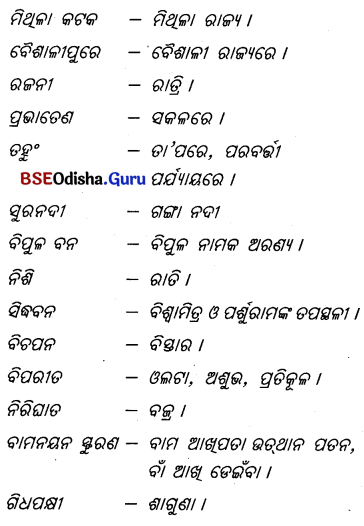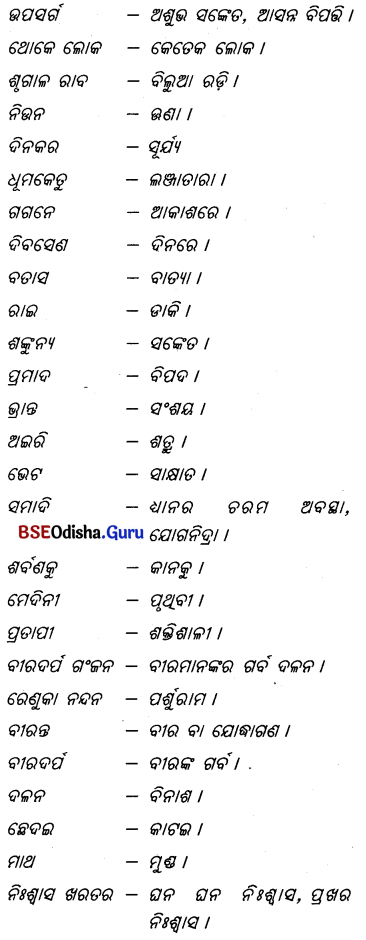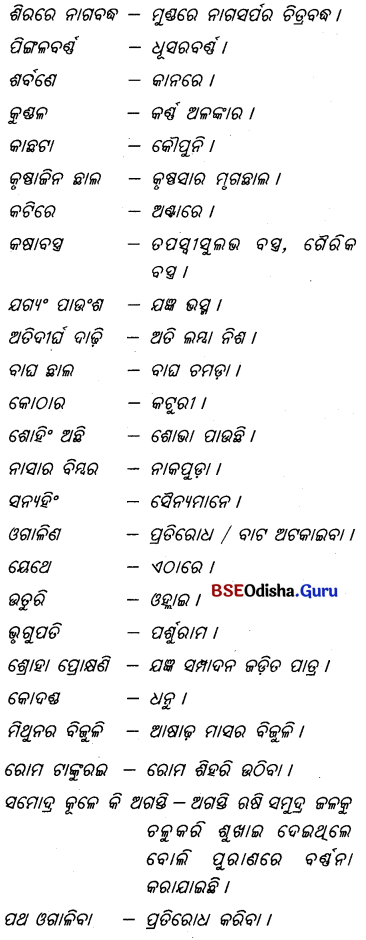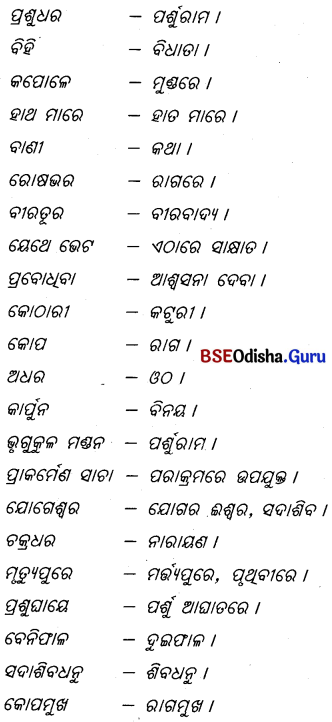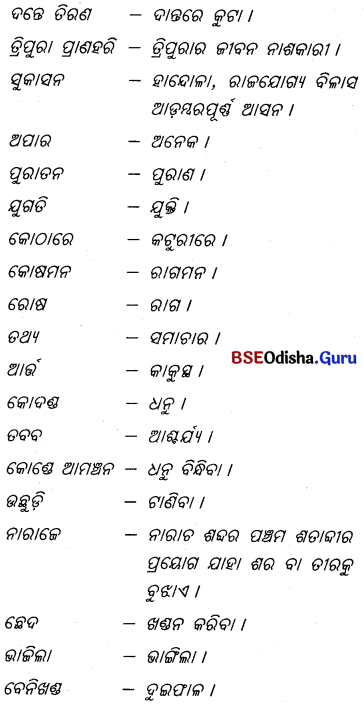Odisha State Board CHSE Odisha Class 12 Optional Odia Solutions Chapter 1 ପର୍ଶୁରାମ ଭେଟ Textbook Exercise Questions and Answers.
+2 2nd Year Odia Optional Chapter 1 ପର୍ଶୁରାମ ଭେଟ Question Answer
ପାଠ୍ୟପୁସ୍ତକସ୍ଥ ଅଭ୍ୟାସ ପ୍ରଶ୍ନବଳୀ ଓ ଉତ୍ତର
(କ) ବିକଳ୍ପ ସହ ସମ୍ଭାବ୍ୟ ଉତ୍ତରମୂଳକ ୧ ନମ୍ବର ବିଶିଷ୍ଟ ପ୍ରଶ୍ନ ।
(ସମ୍ଭାବ୍ୟ ଚାରୋଟି ମଧ୍ୟରୁ ଠିକ୍ ଉତ୍ତରଟି ବାଛି ଲେଖ ।)
Question 1.
ମିଥିଳା କଟକରୁ ବାହାରି ରାମସୀତା କେଉଁଠି ରହିଲେ ?
(କ) ବରୁଣପୁରରେ
(ଖ) ବୈଶାଳୀପୁରରେ
(ଗ) ଜନକପୁରରେ
(ଘ) ଦଣ୍ଡଜବନରେ
ଉ –
(ଖ) ବୈଶାଳୀପୁରରେ ।
Question 2.
ବିଶ୍ଵାମିତ୍ରଙ୍କ ଆଶ୍ରମ କେଉଁଠି ଅବସ୍ଥିତ ?
(କ) ସିଦ୍ଧବନ
(ଖ) ଚିତ୍ରକୂଟବନ
(ଗ) ପଞ୍ଚବଟୀବନ
(ଘ) ଦଣ୍ଡଜବନ
ଉ –
(କ) ସିଦ୍ଧବନ ।
Question 3.
ମନୁଷ୍ୟ ଶରୀର ଉପରେ କେଉଁ ପକ୍ଷୀ ବସିଥିର ରାଜା ଦଶରଥ ଦେଖୁଥିଲେ ?
(କ) ଶୁକ
(ଖ) ଶାରୀ
(ଗ) କାକ
(ଘ) ପିକ
ଉ –
(ଗ) କାକ
![]()
Question 4.
ରେଣୁକା ନନ୍ଦନ କିଏ ?
(କ) ଗୌତମ
(ଖ) ବଶି
(ଗ) ପର୍ଶୁରାମ
(ଘ) ବିଶ୍ଵାମିତ୍ର
ଉ –
(ଗ) ପର୍ଶୁରାମ ।
Question 5.
ପର୍ଶୁରାମଙ୍କର ଧ୍ୟାନ କିପରି ଭାଙ୍ଗିଲା ?
(କ) ବୀରତୂର ଶବ୍ଦରେ
(ଖ) ଘଡ଼ଘଡ଼ି ଶବ୍ଦରେ
(ଗ) ଶାର୍ଦ୍ଦୁଳ ରବରେ
(ଘ) ପକ୍ଷୀଙ୍କ କାକଳିରେ
ଉ –
(କ) ବୀରତୂର ଶବ୍ଦରେ ।
Question 6.
ପର୍ଶୁରାମ କଟିରେ କି ଛାଲ ପିନ୍ଧିଥିଲେ ?
(କ) ବ୍ଯାଘ୍ର ଛାଲ
(ଖ) ସିଂହ ଛାଲ
(ଗ) ସମ୍ବର ଛାଲ
(ଘ) କୃଷ୍ଣାଜିନ ଛାଲ
ଉ –
(ଘ) କୃଷ୍ଣାଜିନ ଛାଲ
Question 7.
ପର୍ଶୁରାମଙ୍କର କୋଦଣ୍ଡର ନାମ କ’ଣ ଥିଲା ?
(କ) ସାରଙ୍ଗ
(ଖ) ଶିବ
(ଗ) ଗାଣ୍ଡିବ
(ଘ) ବୈଷ୍ଣବ
ଉ –
(ଘ) ବୈଷ୍ଣବ ।
Question 8.
ପର୍ଶୁରାମଙ୍କ କୋଠାରକୁ କବି କାହା ସହିତ ତୁଳନା କରିଛନ୍ତି ?
(କ) କାଳଦଣ୍ଡପ୍ରାୟ
(ଖ) କାଳଦଣ୍ଡପ୍ରାୟ
(ଗ) ଧର୍ମଦଣ୍ଡପ୍ରାୟ
(ଘ) ତୁଳାଦଣ୍ଡପ୍ରାୟ
ଉ –
(ଖ) କାଳଦଣ୍ଡପ୍ରାୟ ।
![]()
Question 9.
ପର୍ଶୁରାମଙ୍କର ପିତାଙ୍କ ନାମ କ’ଣ ?
(କ) ଯମଦଗ୍ନି
(ଖ) ଶୁକଦେବ
(ଗ) ଗୌତମ
(ଘ) ଅତ୍ରି
ଉ –
(କ) ଯମଦଗ୍ନି ।
Question 10.
ଭୃଗୁପତି କିଏ ?
(କ) ରାମ
(ଖ) ରାବଣ
(ଗ) ଅଗସ୍ତି
(ଘ) ପର୍ଶୁରାମ
ଉ –
(ଘ) ପର୍ଶୁରାମ ।
Question 11.
ଶିବଧନୁରେ କେଉଁ ଅସୁରର ମୃତ୍ୟୁ ହୋଇଥିଲା ?
(କ) ତାରକାସୁର
(ଖ) ତ୍ରିପୁରାସୁର
(ଗ) ଗୌତମ
(ଘ) ବୃତ୍ତାସୁର
ଉ –
(ଖ) ତ୍ରିପୁରାସୁର
Question 12.
ପର୍ଶୁରାମ କ’ଣ ଥିଲେ ?
(କ) ତାରକାସୁର
(ଖ) ତ୍ରିପୁରାସୁର
(ଗ) କ୍ଷତ୍ରିୟ
(ଘ) ବୃତ୍ତାସୁର
ଉ –
(ଗ) କ୍ଷତ୍ରିୟ ।
![]()
(ଖ) କ୍ଷୁଦ୍ର ଉତ୍ତରମୂଳକ ୧ ନମ୍ବର ବିଶିଷ୍ଟ ପ୍ରଶ୍ନ । ଗୋଟିଏ ବାକ୍ୟରେ ଉତ୍ତର ଲେଖ
Question 1.
‘ପର୍ଶୁରାମ ଭେଟ’ କବିତାର କବି କିଏ ?
ଉ –
ପଞ୍ଚସଖା ଗୋଷ୍ଠୀର ବରେଣ୍ୟ ସାଧକ ଓ ‘ଜଗମୋହନ ରାମାୟଣ’ର ସ୍ରଷ୍ଟା ଭକ୍ତକବି ବଳରାମ ଦାସ ‘ପର୍ଶୁରାମ ଭେଟ’ କବିତାର କବି ଅଟନ୍ତି ।
Question 2.
‘ପର୍ଶୁରାମ ଭେଟ’ କେଉଁ ପୁରାଣ ଗ୍ରନ୍ଥରୁ ଆସିଛି ?
ଉ –
‘ପର୍ଶୁରାମ ଭେଟ’ କବିତାଟି ବଳରାମ ଦାସଙ୍କ ବିରଚିତ ‘ଜଗମୋହନ ରାମାୟଣ’ରୁ ଗୃହୀତ ।
Question 3.
ରାମାୟଣର କେଉଁ କାଣ୍ଡରୁ ‘ପର୍ଶୁରାମ ଭେଟ’ କବିତା ଆସିଛି ?
ଉ –
ରାମାୟଣର ଆଦିକାଣ୍ଡରୁ ‘ପର୍ଶୁରାମ ଭେଟ’ କବିତା ଆସିଛି ।
Question 4.
ସୀତାଙ୍କ ସ୍ଵୟମ୍ବରରେ ରାମଚନ୍ଦ୍ର କେଉଁ ଧନୁ ଭଗ୍ନ କରିଥିଲେ ?
ଉ –
ଜନକନନ୍ଦିନୀ ସୀତାଙ୍କ ସ୍ଵୟମ୍ବରରେ ରଘୁକୁଳତିଳକ ରାମଚନ୍ଦ୍ର ଶିବଧନୁ ଭଗ୍ନ କରିଥିଲେ ।
Question 5.
ପର୍ଶୁରାମଙ୍କର କାହା ସହିତ ଭେଟହେବା କଥା କବିତାରେ କୁହାଯାଇଛି ?
ଉ –
ପର୍ଶୁରାମଙ୍କର ଦଶରଥନନ୍ଦନ ଶ୍ରୀରାମଙ୍କ ସହିତ ଭେଟହେବା କଥା କବିତାରେ କୁହାଯାଇଛି ।
Question 6.
ବିଶ୍ଵାମିତ୍ରଙ୍କ ଆଶ୍ରମ କେଉଁଠାରେ ଅବସ୍ଥିତ ?
ଉ –
ମହର୍ଷି ବିଶ୍ଵାମିତ୍ରଙ୍କ ଆଶ୍ରମ ସିଦ୍ଧବନରେ ଅବସ୍ଥିତ ।
Question 7.
ପର୍ଶୁରାମଙ୍କ ଆଶ୍ରମ କେଉଁଠାରେ ଅବସ୍ଥିତ ?
ଉ –
ପର୍ଶୁରାମଙ୍କ ଆଶ୍ରମ ସିଦ୍ଧବନରେ ଅବସ୍ଥିତ ।
![]()
Question 8.
ରାଜା ଦଶରଥଙ୍କର କେଉଁ ନୟନ ଘନ ଘନ ସ୍ଫୁରଣ ହେଉଥିଲା ?
ଉ –
ଅଯୋଧ୍ୟାପତି ଦଶରଥଙ୍କର ବାମ ନୟନ ଘନ ଘନ ସ୍ଫୁରଣ ହେଉଥିଲା ।
Question 9.
ରାଜା ଦଶରଥଙ୍କର କୁଳଗୁରୁ କିଏ ?
ଉ –
ଋଷିଶ୍ରେଷ୍ଠ ମହର୍ଷି ବଶିଷ୍ଠ ରାଜା ଦଶରଥଙ୍କର କୁଳଗୁରୁ ଅଟନ୍ତି ।
Question 10.
ପର୍ଶୁରାମ ପିଠିରେ କେଉଁ ଛାଲ ପରିଧାନ କରିଥିଲେ ?
ଉ –
ପର୍ଶୁରାମ ପିଠିରେ ବ୍ୟାଘ୍ର ଛାଲ ପରିଧାନ କରିଥିଲେ ।
Question 11.
ଭୃଗୁପତି କିଏ ?
ଉ –
ମହାତେଜା ପର୍ଶୁରାମ ଭୃଗୁପତି ଅଟନ୍ତି ।
Question 12.
ପର୍ଶୁରାମଙ୍କର ପିତାଙ୍କ ନାମ କ’ଣ ?
ଉ –
ପର୍ଶୁରାମଙ୍କର ପିତାଙ୍କ ନାମ ଯମଦଗ୍ନି ଅଟେ ।
Question 13.
ପର୍ଶୁରାମଙ୍କର ଜଟା କେଉଁ ବର୍ଷ ?
ଉ –
ପର୍ଶୁରାମଙ୍କ ଜଟା ପିଙ୍ଗଳବର୍ଣ୍ଣ ଥିଲା ।
Question 14.
ପର୍ଶୁରାମ କର୍ଷରେ କ’ଣ ପିନ୍ଧିଥିଲେ ?
ଉ –
ପର୍ଶୁରାମ କଣ୍ଠରେ କୁଣ୍ଡଳ ପିନ୍ଧିଥିଲେ ।
Question 15.
ପର୍ଶୁରାମଙ୍କର କଟିରେ କ’ଣ ଥିଲା ?
ଉ –
ପର୍ଶୁରାମ କଟିରେ କୃଷ୍ଣାଜିନ ଛାଲ ପରିଧାନ କରିଥିଲେ ।
![]()
Question 16.
ପର୍ଶୁରାମଙ୍କର ଡାହାଣ ହସ୍ତରେ କେଉଁ ଅସ୍ତ୍ର ଥିଲା ?
ଉ –
ପର୍ଶୁରାମଙ୍କର ଡାହାଣ ହସ୍ତରେ କୋଠାର ଅସ୍ତ୍ର ଥିଲା ।
Question 17.
ଇନ୍ଦ୍ରଦେବ କେଉଁ ଧନୁ ଧରିବାକୁ ଅକ୍ଷମ ଥିଲେ ?
ଉ –
ସ୍ୱର୍ଗାଧୂପତି ଇନ୍ଦ୍ରଦେବ ଶିବଧନୁ ଧାରଣ କରିବାକୁ ଅକ୍ଷମ ଥିଲେ ।
Question 18.
ରାମଚନ୍ଦ୍ର କାହା ପ୍ରତି କ୍ରୋଧ ନ କରିବା କଥା କହିଛନ୍ତି ?
ଉ –
ରାମଚନ୍ଦ୍ର ଗୋରୁ ବ୍ରାହ୍ମଣ ତଥା ବ୍ରାହ୍ମଣକୁଳ ଦାତା ପର୍ଶୁରାମଙ୍କ ପ୍ରତି କ୍ରୋଧ ନ କରିବା କଥା କହିଛନ୍ତି ।
Question 19.
ଶିବଧନୁରେ କେଉଁ ଅସୁରର ପ୍ରାଣ ଯାଇଥିଲା ?
ଉ –
ତ୍ରିପୁର ବିଜୟୀ ତ୍ରିପୁରାପୁରର ଶିବଧନୁରେ ପ୍ରାଣ ଯାଇଥିଲା ।
Question 20.
ପର୍ଶୁରାମ ରାମଚନ୍ଦ୍ରଙ୍କୁ କେଉଁ ଦିବ୍ୟଧନୁ କଥା କହିଛନ୍ତି ?
ଉ –
ଯେଉଁ ଧନୁକୁ ସ୍ୱର୍ଗାଧୂପତି ଇନ୍ଦ୍ର ଧାରଣପାଇଁ ଅସମର୍ଥ ଥିଲା ଓ ଯେଉଁ ଧନୁରେ ତ୍ରିପୁରାପୁରର ବିନାଶ ହୋଇଥିଲା ସେହି ଦିବ୍ୟଧନୁ କଥା ପର୍ଶୁରାମ ଶ୍ରୀରାମଙ୍କୁ କହିଛନ୍ତି ।
Question 21.
ରାମଚନ୍ଦ୍ର ପର୍ଶୁରାମଙ୍କଠାରୁ କୋଦଣ୍ଡ କେଉଁ ହସ୍ତରେ ନେଇଥିଲେ ?
ଉ –
ରାମଚନ୍ଦ୍ର ପର୍ଶୁରାମଙ୍କଠାରୁ କୋଦଣ୍ଡ ଦକ୍ଷିଣ ହସ୍ତରେ ଗ୍ରହଣ କରିଥିଲେ ।
Question 22.
ରଘୁମଣି କିଏ ?
ଉ –
ଦଶରଥନନ୍ଦନ ଶ୍ରୀରାମଚନ୍ଦ୍ର ରଘୁମଣି ଅଟନ୍ତି ।
![]()
(ଗ) କ୍ଷୁଦ୍ର ଉତ୍ତରମୂଳକ ୨ ନମ୍ବର ବିଶିଷ୍ଟ ପ୍ରଶ୍ନ । ଦୁଇଟି ବାକ୍ୟରେ ଉତ୍ତର ଲେଖ ।
(ଲେଖା ଓ ଲେଖକଙ୍କ ସୂଚନା ପାଇଁ ୧ ନମ୍ବର ଓ ଉତ୍ତର ପାଇଁ ୧ ନମ୍ବର ।)
Question 1.
କବି ବଳରାମ ଦାସଙ୍କର ଦୁଇଖଣ୍ଡ ପୁସ୍ତକର ନାମ ଲେଖ ।
ଉ –
ଆଲୋଚ୍ୟ ‘ପର୍ଶୁରାମ ଭେଟ’ ଶୀର୍ଷକ କବିତାଟି ଉଦ୍ଧାର କରାଯାଇଅଛି । ବଳରାମ ଦାସଙ୍କର ଅନ୍ୟ ଦୁଇଖଣ୍ଡ ପୁସ୍ତକର ନାମ ହେଲା – (୧) ବଟ ଅବକାଶ ଓ (୨) ଭାବସମୁଦ୍ର ।
Question 2.
ରାମସୀତାଙ୍କ ବିବାହ ପରେ ମିଥୁଳା କଟକରୁ ଆସିଲାବେଳେ ରାଜାମାନେ ସେମାନଙ୍କୁ କ’ଣ ଦେଇଥିଲେ ?
ଉ –
ଆଲୋଚ୍ୟ ‘ପର୍ଶୁରାମ ଭେଟ’ କବିତାଟି ବଳରାମ ଦାସଙ୍କ ରଚିତ ‘ଜଗମୋହନ ରାମାୟଣ’ର ଆଦ୍ୟକାଣ୍ଡର ଅଂଶବିଶେଷ ଅଟେ । କବିଙ୍କ ବର୍ଣ୍ଣନାନୁଯାୟୀ ଦଶରଥନନ୍ଦନ ଶ୍ରୀରାମ ଜନକନନ୍ଦିନୀ ସୀତାଙ୍କୁ ବିବାହ ପରେ ଆଯୋଧ୍ୟା ପ୍ରତ୍ୟାଗମନ ପଥରେ ପଥପାର୍ଶ୍ଵର ରାଜ୍ୟର ରାଜାମାନେ ସେମାନଙ୍କୁ ବିଭିନ୍ନ ଉପହାରମାନ ପ୍ରଦାନ କରି ଆପ୍ୟାୟିତ କରିଥିଲେ ।
Question 3.
ସିଦ୍ଧବନରେ କାହା ସହିତ ଭେଟ ହେଲେ ବିପଦର ଆଶଙ୍କା ରହିଛି ବୋଲି ବଶିଷ୍ଠ କହିଛନ୍ତି ?
ଉ –
‘‘ପର୍ଶୁରାମ ଭେଟ’’ କବିତାଟି କବି ବଳରାମ ଦାସଙ୍କର ‘ଜଗମୋହନ ରାମାୟଣ’ର ଆଦ୍ୟକାଣ୍ଡର ଅଂଶବିଶେଷ ଅଟେ । ଏଠାରେ ମହର୍ଷି ବଶିଷ୍ଠ କ୍ଷତ୍ରିୟ-ଦର୍ପ-ଦଳନ ଯମଦଗ୍ନିଙ୍କ ପୁତ୍ର ପର୍ଶୁରାମଙ୍କ ସହିତ ସିଦ୍ଧବନରେ ଭେଟହେଲେ ବିପଦର ଆଶଙ୍କା ରହିଛି ବୋଲି ସତର୍କ ବାଣୀ ଶୁଣାଇଛନ୍ତି ।
Question 4.
ସୈନ୍ୟସାମନ୍ତ ଯାଇ ରାଜା ଦଶରଥଙ୍କୁ କ’ଣ କହିଲେ ?
ଉ –
ଆଲୋଚ୍ୟ ‘‘ପର୍ଶୁରାମ ଭେଟ’’ କବିତାଟି କବି ବଳରାମ ଦାସଙ୍କ ବିରଚିତ ‘ଜଗମୋହନ ରାମାୟଣ’’ର ଅଂଶବିଶେଷ ଅଟେ । ପ୍ରଳୟ ଅନଳ ସମାନ ଭୟଙ୍କର ଓ ସୂର୍ଯ୍ୟଙ୍କ ସମ ତେଜସ୍ବୀ ପର୍ଶୁରାମଙ୍କ ଆଗମନରେ ସୈନ୍ୟମାନେ ଅତିଶୟ ଭୟଭୀତ ହୋଇ ମହାରାଜା ଦଶରଥଙ୍କୁ ତାଙ୍କର ପଥରୋଧ କରିବା ସମାଚାରକୁ ଅବଗତ କରାଇଥିଲେ ।
![]()
Question 5.
ପର୍ଶୁରାମଙ୍କର ଆଗମନ କଥା ଶୁଣି ରାଜା ଦଶରଥଙ୍କ ଅବସ୍ଥା କ’ଣ ହୋଇଥିଲା ?
ଉ –
‘ପର୍ଶୁରାମ ଭେଟ’’ କବିତାଟି କବି ବଳରାମ ଦାସଙ୍କ ବିରଚିତ ‘ଜଗମୋହନ ରାମାୟଣ’ର ଆଦ୍ୟକାଣ୍ଡର ଅଂଶବିଶେଷ ଅଯେ । ପର୍ଶୁରାମଙ୍କ ଆଗମନ ସମ୍ବାଦ ଅବଗତ ହୋଇ ରାଜା ଦଶରଥ ହତୋତ୍ସାହିତ ହୋଇ ବିଧାତାଙ୍କୁ ସୁମରଣା କରି ଦୁଃଖରେ ଦୀର୍ଘଶ୍ଵାସ ସହ ବଶିଷ୍ଠଙ୍କୁ ଶୋକାକୁଳିତ କଣ୍ଠରେ ସମୁଚିତ ପରାମର୍ଶ ପାଇଁ ପ୍ରାର୍ଥନା କରିଛନ୍ତି ।
Question 6.
ପର୍ଶୁରାମ କେଉଁ ମୁଦ୍ରାରେ ବସିଥିଲେ ଏବଂ କି ପ୍ରକାର ବାଦ୍ୟ ଶୁଣି କ୍ରୋଧୃତ ହୋଇଥିଲେ ?
ଉ –
‘ପର୍ଶୁରାମ ଭେଟ’’ କବିତାଟି କବି ବଳରାମ ଦାସଙ୍କ କୃତ ‘ଜଗମୋହନ ରାମାୟଣ’ର ଆଦ୍ୟକାଣ୍ଡର ଅଂଶବିଶେଷ ଅଟେ । ପର୍ଶୁରାମ ଧ୍ୟାନମୁଦ୍ରାରେ ବସିଥିଲାବେଳେ ବୀରତୂର ଶୁଣି ତାଙ୍କର ସମାଧ୍ ଭାଙ୍ଗିବା ସହ ସେ କ୍ରୋଧାନ୍ଵିତ ହୋଇ ପଡ଼ିଛନ୍ତି ।
Question 7.
ପର୍ଶୁରାମ ତାଙ୍କ ଶରୀରର କେଉଁ ଅଂଶରେ ନାଗବନ୍ଧ ପିନ୍ଧିଥିଲେ ଏବଂ କଟିରେ କ’ଣ ପରିଧାନ କରିଥିଲେ ?
ଉ –
‘ପର୍ଶୁରାମ ଭେଟ’’ କବିତାଟି କବି ବଳରାମ ଦାସଙ୍କ ‘ଜଗମୋହନ ରାମାୟଣ’’ର ଆଦ୍ୟକାଣ୍ଡର ମସ୍ତକରେ ନାଗବନ୍ଧ ପିନ୍ଧିବା ସହ କଟିରେ କାଛଟା ପରିଧାନ କରିଥିଲେ ।
Question 8.
ପର୍ଶୁରାମ ତାଙ୍କ ବାମ ଓ ଦକ୍ଷିଣ ହସ୍ତରେ କ’ଣ କ’ଣ ଧାରଣ କରିଥିଲେ ?
ଉ –
‘‘ପର୍ଶୁରାମ ଭେଟ’’ କବିତାଟି କବି ବଳରାମ ଦାସଙ୍କ ‘ଜଗମୋହନ ରାମାୟଣ’’ର ଆଦ୍ୟକାଣ୍ଡର ଅଂଶବିଶେଷ ଅଟେ । ମହାତେଜା ପର୍ଶୁରାମ ବାମହସ୍ତରେ ଧନୁ ଓ ଡାହାଣ ହସ୍ତରେ କୋଠାର ଅସ୍ତ୍ର ଧାରଣ କରିଥିଲେ ବୋଲି କବି ଉଲ୍ଲେଖ କରିଛନ୍ତି ।
Question 9.
ପର୍ଶୁରାମ କାହାର ନନ୍ଦନ ଥିଲେ ଓ କେଉଁ କୁଳକୁ ମଣ୍ଡନ କରିଥିଲେ ?
ଉ –
‘‘ପର୍ଶୁରାମ ଭେଟ’’ କବିତାଟି କବି ବଳରାମ ଦାସଙ୍କ ‘ଜଗମୋହନ ରାମାୟଣ’’ର ଆଦ୍ୟକାଣ୍ଡର ଅଂଶବିଶେଷ ଅଟେ । ପର୍ଶୁରାମ ପିତା ଯମଦଗ୍ନି ଓ ମାତା ରେଣୁକାଙ୍କର ପୁତ୍ର ଥିଲେ ଯେକି ଭୃଗୁକୁଳକୁ ମଣ୍ଡନ କରୁଥିଲେ ।
Question 10.
‘‘ମେରୁ ହୁଂ ଗରୁ ଏବଂ ବଜ୍ରହୁ ଆଣ୍ଟ’’ କାହା ବିଷୟରେ କୁହାଯାଇଛି ଏବଂ କିଏ କହିଛନ୍ତି ?
ଉ –
‘‘ପର୍ଶୁରାମ ଭେଟ’’ କବିତାଟି କବି ବଳରାମ ଦାସଙ୍କ ‘ଜଗମୋହନ ରାମାୟଣ’’ର ଆଦ୍ୟକାଣ୍ଡର ଅଂଶବିଶେଷ ଅଟେ । ମହାବଳଶାଳୀ ପର୍ଶୁରାମ ଶ୍ରୀରାମ ଭଗ୍ନ କରିଥିବା ଶିବଧନୁକୁ ମେରୁ ହୁଂ ଓ ବଜ୍ର ହୁଂ ଆଣ୍ଟ ବୋଲି ସ୍ଵମତ ବ୍ୟକ୍ତ କରିଛନ୍ତି ।
![]()
(ଘ) ଅଳ୍ପ ଦୀର୍ଘ ଉତ୍ତରମୂଳକ ୩ ନମ୍ବର ବିଶିଷ୍ଟ ଅଳ୍ପ ଦୀର୍ଘ ଉତ୍ତରମୂଳକ ୩ ନମ୍ବର ବିଶିଷ୍ଟ ପ୍ରଶ୍ନ । ୩୦ଟି ଶବ୍ଦ ମଧ୍ଯରେ ଉତ୍ତର ଲେଖ ।
(ଲେଖା ଓ ଲେଖକପାଇଁ ୧ ନମ୍ବର ଓ ଉତ୍ତର ପାଇଁ ୨ ନମ୍ବର ।)
Question 1.
ପକ୍ଷୀମାନେ ଘୋର କଳରବ କରି ଆକାଶରେ ଉଡ଼ିବାରୁ କେଉଁ ସୂଚନା ମିଳେ ?
ଉ –
ଆଲୋଚ୍ୟ “ପର୍ଶୁରାମ ଭେଟ’’ କବିତାଟି କବି ବଳରାମ ଦାସଙ୍କ “ଜଗମୋହନ ରାମାୟଣ’’ର ଆଦ୍ୟକାଣ୍ଡରୁ ଉଦ୍ଧାର କରାଯାଇଛି । ମର୍ଯ୍ୟାଦା ପୁରୁଷ ଶ୍ରୀରାମଚନ୍ଦ୍ର ମିଥ୍ଳାରେ ଶିବଧନୁ “ଜଗମୋହନ ରାମାୟଣ” ର ପାଣିଗ୍ରହଣ କରିଛନ୍ତି । ମହାରାଜ ଦଶରଥ ପୁତ୍ର-ବଧୂଙ୍କସହ ସୈନ୍ୟସାମନ୍ତ୍ରମାନଙ୍କୁ ନେଇ ଉତ୍ସବ-ମୁଖରିତ ପରିବେଶରେ ସ୍ଵଦେଶ ପ୍ରତ୍ୟାବର୍ତ୍ତନ କରୁଥିବାବେଳେ ଶାଗୁଣା ପକ୍ଷୀର ଆକାଶରେ ଉଡ଼ିବୁଲିବା ଏବଂ କାକପକ୍ଷୀର ମନୁଷ୍ୟ ଶରୀର ଉପରେ ଆକସ୍ମିକ ଉପବେଶନ କରିବାର ଦୃଶ୍ୟ ଅବଲୋକ କରିଛନ୍ତି । ପକ୍ଷୀମାନଙ୍କର ଏହିପରି ବିଚରଣରୁ ରାଜା ଦଶରଥ ଉପସର୍ଗ ବା ଅଶୁଭ ସଂକେତ ବା ଆକସ୍ମିକ ବିପଦର ଆଶଙ୍କାରେ ମ୍ରିୟମାଣ ହୋଇ ଉଠିଛନ୍ତି ।
Question 2.
ମୃଗମାନେ ଗ୍ରଦକ୍ଷଣ କରିଯିବାର ଲକ୍ଷଣ କ’ଣ ହୋଇପାରେ ?
ଉ –
ଆଲୋଚ୍ୟ ‘ପର୍ଶୁରାମ ଭେଟ’’ କବିତାଟି ଭକ୍ତକବି ବଳରାମ ଦାସଙ୍କ ‘ଜଗମୋହନ ରାମାୟଣ’’ର ଆଦ୍ୟକାଣ୍ଡରୁ ଅଂଶବିଶେଷ ଅଟେ । କବିଙ୍କ ବର୍ଣ୍ଣନା ଅନୁଯାୟୀ ଅଯୋଧ୍ୟାପତି ଦଶରଥ ମିଥିଲାରେ ଶ୍ରୀରାମ ପ୍ରଭୃତି ପୁତ୍ରମାନଙ୍କର ବିବାହ ସମାପନ କରି ସ୍ଵଦେଶ ପ୍ରତ୍ୟାବର୍ତ୍ତନ ସମୟରେ ପଥସ୍ଥିତ ସିଦ୍ଧବନରେ ଅଶୁଭ ଲକ୍ଷଣ ବା ଉପସର୍ଗମାନ ଦୃଷ୍ଟିଗୋଚର ହୋଇଥିଲା । ସେହିସବୁ ଉପସର୍ଗମାନଙ୍କ ମଧ୍ୟରେ କାଉ ଓ ଶାଗୁଣାଙ୍କର ଆବିର୍ଭାବ ସହ ଶୃଗାଳମାନେ ଶ୍ରୀରାମଙ୍କ ଆଗରେ ବିକଟାଳ ଚିତ୍କାର କରୁଥିଲେ ।
(ବି.ଦ୍ର. – ମୃଗମାନେ ପ୍ରଦକ୍ଷଣ କରିବା କଥା ପାଠ୍ୟପୁସ୍ତକ ଅନ୍ତର୍ଭୁକ୍ତ ‘ପର୍ଶୁରାମ ଭେଟ’ କବିତାରେ ଆଦୌ ଉଲ୍ଲେଖ କରାଯାଇନାହିଁ ।)
Question 3.
ରାଜା ଦଶରଥଙ୍କ ମନରେ ଆଶଙ୍କା ଦେଖାଦେଇଥିଲା କାହିଁକି ?
ଉ –
ଆଲୋଚ୍ୟ “ପର୍ଶୁରାମ ଭେଟ’’ କବିତାଟି କବି ବଳରାମ ଦାସଙ୍କ ବିରଚିତ “ଜଗମୋହନ ରାମାୟଣ’’ର ଆଦ୍ୟକାଣ୍ଡର ଅଂଶବିଶେଷ ଅଟେ । କବିଙ୍କ ବର୍ଣ୍ଣନା ଅନୁଯାୟୀ ରାଜା ଦଶରଥ ପୁତ୍ରବଧୂଙ୍କ ସହ ଉତ୍ସବ ମୁଖରିତ ହୋଇଥିଲା । ତାଙ୍କର ବାମ ନୟନର ସ୍ଫୁରଣସହ କାଉର ମଣିଷ ଶରୀରରେ ବସିବା, ଶୃଗାଳର ରଡ଼ି ସହ କୁହୁଡ଼ିର ଆବିର୍ଭାବ ପ୍ରଭୃତି ବିପରୀତ ଲକ୍ଷଣମାନ ଦୃଷ୍ଟିପଥାରୂଢ଼ ହେବାରୁ ରାଜା ଆସନ୍ନ ବିପର୍ଯ୍ୟୟର ଆଶଙ୍କାରେ ମ୍ରିୟମାଣ ହୋଇ ଉଠିଥିଲେ ।
Question 4.
ପର୍ଶୁରାମଙ୍କର ଧାନ ଭାଙ୍ଗିବାର କାରଣ କ’ଣ ?
ଉ –
ଆଲୋଚ୍ୟ “ପର୍ଶୁରାମ ଭେଟ’’ କବିତାଟି କବି ବଳରାମ ଦାସଙ୍କ “ଜଗମୋହନ ରାମାୟଣ’’ର ଆଦ୍ୟକାଣ୍ଡର ଅଂଶବିଶେଷ ଅଟେ । କବିଙ୍କ ବର୍ଣ୍ଣନାଯାୟୀ ମର୍ଯ୍ୟାଦାପୁରୁଷ ଶ୍ରୀରାମ ମିଥିଲା କଟକରେ ଶିବଧନୁ ଭଗ୍ନକରି ସୀତାଙ୍କ ପାଣିଗ୍ରହଣ ପରେ ସୈନ୍ୟସାମନ୍ତଙ୍କ ସହ ଉତ୍ସବ-ମୁଖରିତ ପରିବେଶରେ ବୀରତୂର ବଢ଼ାଇ ସ୍ଵଦେଶ ପ୍ରତ୍ୟାବର୍ତ୍ତନ କରୁଥିଲେ । ପଥପ୍ରାନ୍ତରେ ଥିବା ସିଦ୍ଧବନରେ ଧାନରତ ପର୍ଶୁରାମଙ୍କର ବୀରତୂର ଧ୍ୱନି ଶ୍ରବଣ ଓ ସୈନ୍ୟମାନଙ୍କ କୋଳାହଳରେ ଧ୍ୟାନଭଇଂ ହୋଇଯାଇଥିଲା ।
![]()
Question 5.
ପର୍ଶୁରାମ କ୍ଷତ୍ରିୟଙ୍କର ଶତ୍ରୁ ଥିଲେ କାହିଁକି ?
ଉ –
ଆଲୋଚ୍ୟ “ପର୍ଶୁରାମ ଭେଟ’’ କବିତାଟି କବି ବଳରାମ ଦାସଙ୍କ “ଜଗମୋହନ ରାମାୟଣ’’ ଆଦ୍ୟକାଣ୍ଡର ଅଂଶବିଶେଷ ଅଟେ । ପର୍ଶୁରାମ ଋଷିଙ୍କର ପୁତ୍ର ଓ ବର୍ଷରେ ବ୍ରାହ୍ମଣ ଥିଲେ । ମହର୍ଷି ଯମଦଗ୍ନିଙ୍କୁ କ୍ଷତ୍ରିୟରାଜା ସହସ୍ରାର୍ଜୁନ (କାର୍ତବୀର୍ଯ୍ୟ ) ଅନ୍ୟାୟଭାବେ ହତ୍ୟାକରି ତାଙ୍କଠାରୁ କାମଧେନୁକୁ ଅପହରଣ କରିବାର ଅପଚେଷ୍ଟା କରିଥିଲେ । ତେଣୁ ପିତୃହତ୍ୟାର ପ୍ରତିଶୋଧ ପାଇଁ ମ`ହାବାର ପର୍ଶୁରାମ ସମସ୍ତ ପୃଥିବୀକୁ କ୍ଷତ୍ରିୟଶୂନ୍ୟ କରିବାର ଦୃଢ଼ସଂକଳ୍ପ ଗ୍ରହଣକରି ସେମାନଙ୍କର ଶତ୍ରୁ ହୋଇପଡ଼ିଥିଲେ ।
Question 6.
ପର୍ଶୁରାମ କ୍ରୋଧ ହେବାର କାରଣ କ’ଣ ?
ଉ –
ଆଲୋଚ୍ୟ “ପର୍ଶୁରାମ ଭେଟ’’ କବିତାଟି କବି ବଳରାମ ଦାସଙ୍କ “ଜଗମୋହନ ରାମାୟଣ’’ ର ଆଦ୍ୟକାଣ୍ଡର ଅଂଶବିଶେଷ ଅଟେ । ପର୍ଶୁରାମ ନିଜ ପିତୃହତ୍ୟାର ପ୍ରତିଶୋଧରେ ଜର୍ଜରିତ ହୋଇ କ୍ଷତ୍ରିୟମାନଙ୍କର ଦର୍ପ ଓ ବୀରତ୍ଵର ଘୋର ପ୍ରତିଦ୍ବନ୍ଦୀ ଥିଲେ । ମହାରାଜା ଦଶରଥ ନବବିବାହିତ ପୁତ୍ରବଧୂଙ୍କ ସହ ବୀରତ୍ବର ବଜାଇ ସଗୌରବେ ସ୍ଵଦେଶ ପ୍ରତ୍ୟାବର୍ତ୍ତନବେଳେ ସିଦ୍ଧବନସ୍ଥିତ ପର୍ଶୁରାମ ଆଶ୍ରମରେ ଉପନୀତ ହୋଇଛନ୍ତି । ସୈନ୍ୟମାନଙ୍କ କୋଳାହଳ ଓ ବୀରତୂର ଶୁଣି ପର୍ଶୁରାମ ପୂର୍ବର ପ୍ରତିଶୋଧକୁ ସ୍ମୃତିଚାରଣ କରି କ୍ରୋଧାନ୍ବିତ ହୋଇପଡ଼ିଛନ୍ତି ।
Question 7.
ପର୍ଶୁରାମଙ୍କର ବେଶଭୂଷା କ’ଣ ଥିଲା ?
ଉ –
ଆଲୋଚ୍ୟ ‘ପର୍ଶୁରାମ ଭେଟ’’ କବିତାଟି କବି ବଳରାମ ଦାସଙ୍କ ‘ଜଗମୋହନ ରାମାୟଣ’ର ଆଦ୍ୟକାଣ୍ଡର ଆଦ୍ୟକାଣ୍ଡର ଅଂଶବିଶେଷ ଅଟେ । କବିଙ୍କ ବର୍ଣ୍ଣନା ଅନୁଯାୟୀ ପର୍ଶୁଯାୟୀ ଏକାଧାରାର ବୀରୋଚିତ ଓ ତପସ୍ଵୀସଲଭ ବେଶଭୂଷାରେ ଶୋଭାପାଉଥିଲେ । ତାଙ୍କର ପିଙ୍ଗଳବର୍ଣ୍ଣ ଜଟା ଶିରରେ ନାଗବନ୍ଧ, କଣ୍ଠରେ କୁଣ୍ଡଳ, କଟୀରେ କୃଷ୍ଣସାର ମୃଗର ଛାଲ ଓ ତୁଳସୀ ରୁଦ୍ରାକ୍ଷରମାଳ ଦୀର୍ଘଦାଢ଼ି, କୁଶ ମନ୍ତ୍ରପୋଥ୍, ଯଜ୍ଞର ପ୍ରୋକ୍ଷଣି ସାଙ୍ଗକୁ ବାମହାତରେ ବୈଷ୍ଣବଧନୁ ଓ ଡାହାଣ ହସ୍ତରେ କୋଠାର । ତାଙ୍କର ଏକାଧାରରେ ବୀରୋଚିତ ଓ ତପସ୍ଵୀସୁଲଭରୁ ବିଚିତ୍ର ଅଭୂଷଣର ପରିଚୟ ମିଳୁଥିଲା ।
Question 8.
ପର୍ଶୁରାମଙ୍କ ଆଗମନରେ ଦଶରଥଙ୍କ ସୈନ୍ୟସାମନ୍ତ ଛତ୍ରଭଙ୍ଗ ଦେଲେ ନାହିଁକି ?
ଉ –
ଆଲୋଚ୍ୟ ‘ପର୍ଶୁରାମ ଭେଟ’ କବିତାଟି କବି ବଳରାମ ଦାସଙ୍କର ବିରଚିତ ‘ଜଗମୋହନ ରାମାୟଣ’ର ଆଦ୍ୟକାଣ୍ଡରୁ ଉଦ୍ଧାର କରାଯାଇଛି । ମହାତେଜା ପର୍ଶୁରାମଙ୍କ ବୀରବେଶ, ନୟନର ଅଗ୍ନିସମ ତେଜ ସଦର୍ଶନରେ ଅଯୋଧ୍ୟାପତି ଦଶରଥଙ୍କ ସୈନ୍ୟସାମନ୍ତ ମହାଭୟ ପାଇଥିଲେ । ସତେଯେପରି ସୂର୍ଯ୍ୟଦେବତା ଧ୍ବଂସସାଧନ ନିମିତ୍ତ ସୈନ୍ୟସାମନ୍ତମାନେ ଛତ୍ରଭଙ୍ଗ ଦେଲେ ।
Question 9.
ପର୍ଶୁରାମଙ୍କୁ ସମ୍ମୁଖରେ ଦେଖୁ ରାଜା ଦଶରଥ କ’ଣ କଲେ ?
ଉ –
ଆଲୋଚ୍ୟ ‘ପର୍ଶୁରାମ ଭେଟ’’ କବିତାଟି କବି ବଳରାମ ଦାସଙ୍କ କୃତ ‘ଜଗମୋହନ ରାମାୟଣ’ର ଆଦ୍ୟକାଣ୍ଡରୁ ଉଦ୍ଧାର କରାଯାଇଅଛି । ଏଠାରେ କବିଙ୍କ ବର୍ଣ୍ଣନା ଅନୁଯାୟୀ ପର୍ଶୁରାମଙ୍କୁ ସମ୍ମୁଖରେ ଦେଖ୍ ରାଜା ଦଶରଥ ରଥରୁ ଅବତରଣ କରି ବିନମ୍ରତାର ସହିତ ନମସ୍କାର କରିଥିଲେ । ଯମଦଗ୍ନିପୁତ୍ର ପର୍ଶୁରାମଙ୍କ ଦର୍ଶନକୁ ସେ ତାଙ୍କର ପୁଣ୍ୟର ଫଳ ବୋଲି କହି ତାଙ୍କୁ ପ୍ରୀତ କରିବା ପାଇଁ ସ୍ତୁତିଗାନ କରିଥିଲେ ।
![]()
Question 10.
ରାଜା ଦଶରଥ ପର୍ଶୁରାମଙ୍କୁ ଗୁହାରି କରିଛନ୍ତି କାହିଁକି ?
ଉ –
ଆଲୋଚ୍ୟ ‘ପର୍ଶୁରାମ ଭେଟ’’ କବିତାଟି କବି ବଳରାମ ଦାସଙ୍କ କୃତ ‘ଜଗମୋହନ ରାମାୟଣ’ର ଆଦ୍ୟକାଣ୍ଡର ଅଂଶବିଶେଷ ଅଟେ । କବିଙ୍କ ବର୍ଣ୍ଣନା ଅନୁଯାୟୀ ପ୍ରାଣପ୍ରିୟ ପୁତ୍ର ଶ୍ରୀରାମଙ୍କ ପ୍ରାଣ ରକ୍ଷାପାଇଁ ରାଜା ଦଶରଥ ପର୍ଶୁରାମଙ୍କର ପାଦତଳେ ପଡ଼ି ଦନ୍ତରେ ତିରଣଧରି ଗୁହାରି କରିଥିଲେ । ପୁତ୍ର ଶ୍ରୀରାମଙ୍କ ବଦଳରେ ତାଙ୍କୁ ନିଧନକରି ନିଜର କ୍ରୋଧ ଶାନ୍ତ କରିବାପାଇଁ ରାଜା ଦଶରଥ ପର୍ଶୁରାମଙ୍କ ପାଖରେ ବ୍ୟାକୁଳ ଭାବରେ ପ୍ରାର୍ଥନା କରିଥିଲେ ।
Question 11.
‘‘ବ୍ରହ୍ମଣ ବ୍ରହ୍ମ ତୁ ଯୋଗେଣ ଯୋଗେଶ୍ଵର’’ ଏକଥା କିଏ ଓ କାହିଁକି କହିଛନ୍ତି ?
ଉ –
ଆଲୋଚ୍ୟ “ପର୍ଶୁରାମ ଭେଟ’’ କବିତାଟି କବି ବଳରାମ ଦାସଙ୍କ ‘ଜଗମୋହନ ରାମାୟଣ’’ର ଆଦ୍ୟକାଣ୍ଡର ଅନ୍ତର୍ଭୁକ୍ତ ଅଟେ । ପ୍ରଶ୍ନନୁଯାୟୀ ରାଜା ଦଶରଥ ପୁତ୍ର ଶ୍ରୀରାମଙ୍କ ସୁରକ୍ଷା ନିମନ୍ତେ କ୍ଷତ୍ରିୟ-କୁଳ-ବିନାଶକାରୀ ପର୍ଶୁରାମଙ୍କର ବିଭିନ୍ନ ପ୍ରକାର ପ୍ରଶଂସାଗାନ କରିଛନ୍ତି । ସେ ପର୍ଶୁରାମଙ୍କୁ ତପସ୍ବୀଙ୍କ ଶ୍ରେଷ୍ଠ, କ୍ଷତ୍ରିୟଙ୍କର ଯମ, ଦୟା ମଧ୍ୟରେ ଧର୍ମ, ସହିଷ୍ଣୁତାରେ ଧରିତ୍ରୀ, ଜୀବରୂପୀ ବ୍ରହ୍ମ ମଧ୍ୟରେ ପରମବ୍ରହ୍ମ ଓ ସମସ୍ତ ଯୋଗର ଫଳଦାୟକ ଯୋଗେଶ୍ଵର ବୋଲି ବର୍ଣ୍ଣନା କରିଛନ୍ତି ।
Question 12.
‘‘ବୀରଦର୍ପ ଗଞ୍ଜନ ମୁଁ ବୀରଙ୍କର ନାଥ’’ – ଏକଥା କିଏ ଓ କାହିଁକି କହିଛନ୍ତି ?
ଉ –
ଆଲୋଚ୍ୟ ‘‘ପର୍ଶୁରାମ ଭେଟ’’ କବିତାଟି କବି ବଳରାମ ଦାସଙ୍କ ‘ଜଗମୋହନ ରାମାୟଣ’’ର ଆଦ୍ୟକାଣ୍ଡର ଅନ୍ତର୍ଭୁକ୍ତ ଅଟେ । କବିଙ୍କ ବର୍ଣ୍ଣନାନୁଯାୟୀ ରାଜା ଦଶରଥ ପୁତ୍ରବଧୂଙ୍କ ସହ ଉତ୍ସବମୁଖରିତ ପରିବେଶରେ ପର୍ଶୁରାମଙ୍କ ପାଇଁ ଅସହ୍ୟ । କାରଣ ସେ ନିଜକୁ ବୀରମାନଙ୍କର ଦର୍ପ ବିନାଶକାରୀ ଭାବରେ ପ୍ରମାଣିତ କରିଛନ୍ତି । ତାଙ୍କ ଆଗରେ ବୀରତ୍ଵର ସମସ୍ତ ଦମ୍ଭ ଓ ଆସ୍ଫାଳନ ବ୍ୟର୍ଥ ଏବଂ ଯେ ବୀରତ୍ଵର ଗାରିମା ଦେଖାଏ ସେ ତାହାର ଶିରଛେଦ ବର୍ଣ୍ଣନା କରିଛନ୍ତି ।
![]()
(ଙ) ଦୀର୍ଘ ଉତ୍ତରମୂଳକ ୫ ନମ୍ବର ବିଶିଷ୍ଟ ପ୍ରଶ୍ନ । ୧୫୦ଟି ଶବ୍ଦ ମଧ୍ୟରେ ଉତ୍ତର ଲେଖ ।
Question 1.
“ପର୍ଶୁରାମ ଭେଟ” କବିତାର ଭାବାଦର୍ଶ ଉଲ୍ଲେଖ କର ।
କିମ୍ବା, ଆଲୋଚ୍ୟ ‘ପର୍ଶୁରାମ ଭେଟ’’ କବିତାର ବୈଶିଷ୍ଟ୍ୟ ପ୍ରତିପାଦନ କର ।
ଉ –
ଭକ୍ତକବି ବଳରାମ ଦାସ ପଞ୍ଚସଖା ସାହିତ୍ୟର ବରେଣ୍ୟ ସାଧକ ତଥା ବିଶିଷ୍ଟ କାବ୍ୟକାର ଥିଲେ । ତାଙ୍କର ସମସ୍ତ ରଚନା ମଧ୍ୟରେ ‘ଜଗମୋହନ ରାମାୟଣ’ ଶ୍ରେଷ୍ଠକୃତି ଅଟେ । ଆଲୋଚ୍ୟ “ଜଗମୋହନ ରାମାୟଣ’’ର ଆଦ୍ୟକାଣ୍ଡରୁ ଉଦ୍ଧାର କରାଯାଇଛି । କବିଙ୍କର ‘ଜଗମୋହନ ରାମାୟଣ’’ ମୂଳ ସଂସ୍କୃତ ରାମାୟଣର ଆକ୍ଷରିକ ଅନୁବାଦ ନୁହେଁ । ବରଂ ଅନ୍ୟପକ୍ଷରେ କବି ମୂଳ ରାମାୟଣର କଥାବସ୍ତୁକୁ ଆଧାର କରି ନିଜସ୍ଵ ସୃଜନୀକଳାର ସୁବିନିଯୋଗରେ ଉତ୍କଳର ସଂସ୍କୃତି, ପରମ୍ପରା, ସାମାଜିକ ଚଳଣି ତଥା ଲୋକବିଶ୍ଵାସକୁ ନେଇ ଏକ ଅଭିନବ କାବ୍ୟର ସୃଷ୍ଟ କରିଛନ୍ତି ।
ଆଲୋଚ୍ୟ ‘ପର୍ଶୁରାମ ଭେଟ’’ କବିତାଟି ଶ୍ରୀରାମଙ୍କ ଶିବଧନୁ ଭଗ୍ନ ତଥା ସୀତା ବିବାହରେ ପରବର୍ତ୍ତୀ ପର୍ଯ୍ୟାୟର କଥାବସ୍ତୁ ଅଟେ । ମର୍ଯ୍ୟାଦାପୁରୁଷ ଶ୍ରୀରାମଚନ୍ଦ୍ର ଜନକନନ୍ଦିନୀ ସୀତାଙ୍କ ପାଣିଗ୍ରହଣ କରି ସ୍ଵଦେଶ ଅଭିମୁଖେ ଯାତ୍ରା
କରିଛନ୍ତି । ପିତା ଦଶରଥ ଓ କୁଳଗୁରୁ ବଶିଷ୍ଠଙ୍କ ସହ ଅଯୋଧ୍ୟାର ସୈନ୍ୟବଳ ବୀରଦୂର ବଜାଇ ମହା ଉଲ୍ଲାସରେ ପ୍ରଦାନ କରିଛନ୍ତି । ସେମାନଙ୍କର ଗନ୍ତବ୍ୟମାର୍ଗରେ ସିଦ୍ଧବନସ୍ଥିତ ପର୍ଶୁରାମଙ୍କର ଆଶ୍ରମ ପଡ଼ିଛି । ସେହି ସମୟରେ ରାଜା ଦଶରଥଙ୍କର ବିପରୀତ ଅଶୁଭସୂଚକ ଲକ୍ଷଣମାନ ଦୃଷ୍ଟିଗୋଚର ହୋଇଛି । ସେହିସବୁ ଉପସର୍ଗମାନଙ୍କ ମଧ୍ୟରେ ପର୍ବତ ଉପରେ ଆକସ୍ମିକ ବଜ୍ରପାତ, ଦଶରଥଙ୍କର୍ ବାମନୟନର ସ୍ଫୁରଣ, ଶାଗୁଣା ପକ୍ଷୀର ଭ୍ରମଣ, ମନୁଷ୍ୟ ଶରୀର ଉପରେ କାକର ଉପବେଶନ ପ୍ରଭୃତି ଅନ୍ୟତମ ଥିଲା । ପୁତ୍ର ଶ୍ରୀରାମଙ୍କ ସମ୍ମୁଖରେ ମଧ୍ୟ ଶୃଗାଳର ବିକଟାଳ ରଡ଼ି ଦଶରଥଙ୍କୁ ସ୍ତବ୍ଧ କରିଦେଇଛି । ସୂର୍ଯ୍ୟଙ୍କର କିରଣ ହ୍ରାସ ସହ, ଧୂମକେତୁର ଆବିର୍ଭାବ, ପ୍ରବଳ ବାତ୍ୟାର ତାଣ୍ଡବ ପ୍ରଭୃତି ଅଶୁଭ ପ୍ରାକୃତିକ ସଂଯୋଗରେ ରାଜା ଦଶରଥ ଆସନ୍ନ ବିପଦର ଆଶଙ୍କାରେ ମ୍ରିୟମାଣ ହୋଇଉଠିଛନ୍ତି ।
କୁଳଗୁରୁ ବଶିଷ୍ଠଙ୍କୁ ସେ ନିଜ ମନରେ ଅନ୍ତର୍ଦାହକୁ ନିବେଦନ କରିଛନ୍ତି । କବି ବଳରାମଙ୍କ ବର୍ଣ୍ଣନାରେ –
“ୟେ ଶକୁନ୍ୟମାନ ଯେ ବିପରୀତ ବିଶଇ
ମୋହୋର ମନକୁ ଯେ ଶୁଭ ନ ଆସଇ ।’’
ଆବିର୍ଭାବ ହୋଇଛି । ଶିରରେ ନାଗବନ୍ଧ, କଷାୟ-ବସ୍ତ ପରିହିତ ପିଙ୍ଗଳାଜଟା ଓ ତୁଳସୀ ରୁଦ୍ରାକ୍ଷମାଳ ବିଭୂଷିତ ହୋଇଥିବା ପର୍ଶୁରାମଙ୍କର ବାମ ହାତରେ ବୈଷ୍ଣବଧନୁ ଓ ଡାହାଣ ହାତରେ କୁଠାର ଶୋଭା ପାଉଥିଲା । ଏକାଧାରରେ ତପସ୍ବୀ ସୁଲଭ ଓ ବୀରତ୍ଵର ବେଶଭୂଷା ବିଭୂଷିତ ପର୍ଶୁରାମଙ୍କ ପାଖରେ ରାଜା ଦଶରଥଙ୍କର ସମସ୍ତ କାକୁସ୍ଥ ନିବେଦନ ବ୍ୟର୍ଥ ହୋଇଛି । ପୁତ୍ରର ସୁରକ୍ଷା ପାଇଁ ସେ ବାରମ୍ବାର ପ୍ରାର୍ଥନା କରିଛନ୍ତି ।
ଅନ୍ୟପକ୍ଷରେ ସ୍ୱର୍ଗାଧୂପତି ଇନ୍ଦ୍ରଦେବର ଯେଉଁ ଶିବଧନୁକୁ ଚାଳନା କରିବାକୁ ଅସମର୍ଥ, ଯେଉଁ ଧନୁରେ ତ୍ରିପୁର ବିଜୟୀ ତ୍ରିପୁରାସୁରର ଧ୍ଵଂସସାଧନ ହୋଇଥିଲା ସେ ବିରାଟ ଶିବଧନୁକୁ ଭଗ୍ନ କରିଥିବା ମହାବୀର ଶ୍ରୀରାମଙ୍କ ପ୍ରତି ପର୍ଶୁରାମ ଈର୍ଷାପରାୟଣ ହୋଇଉଠିଛନ୍ତି । ସେ ତାଙ୍କର ବୈଷ୍ଣବଧନୁରେ ଗୁଣ ଚଢ଼ାଇବା ପାଇଁ ଶ୍ରୀରାମଙ୍କୁ ବାଧ୍ୟ କରିଛନ୍ତି ଓ ମର୍ଯ୍ୟାଦାପୁରୁଷ ଶ୍ରୀରାମ ଅନାୟସରେ ସେଥୁରେ ଗୁଣ ଚଢ଼ାଇ ତାହାକୁ ଦୁଇଫାଳ କରିବାସହ ତେଜସ୍ବୀ ପର୍ଶୁରାମଙ୍କର ସମସ୍ତ ଦମ୍ଭ ଓ ଆସ୍ଫାଳନକୁ ବ୍ୟର୍ଥ କରିଦେଇଛନ୍ତି ।
ଯୁଗେ ଯୁଗେ ଦମ୍ଭ, ଦର୍ପ ଓ ଅହଙ୍କାର ନିକଟରେ ଶୀଳତା ଓ ବିନମ୍ରତା ବିଜୟଲାଭ କରେ । ଶ୍ରୀରାମ ପର୍ଶୁରାମଙ୍କର ପରଲୋକର ସମସ୍ତ ପାପଭାର ଛେଦନ କରିଛନ୍ତି ଓ ପର୍ଶୁରାମ ସେହିଦିନଠାରୁ କ୍ଷତ୍ରିୟକୁଳ ପାଇଁ ହିଂସ୍ର -ଆଚରଣକୁ ପରିତ୍ୟାଗ କରିଛନ୍ତି । ରାମ ଓ ପର୍ଶୁରାମଙ୍କର ଏହି ସାକ୍ଷାତକାରକୁ ନେଇ ଏକ ଆପ୍ତବାକ୍ୟର ଯଥାର୍ଥତା ପ୍ରତୀୟମାନ ହୁଏ –
“ଉଗ୍ରତା ପତନ ବ୍ୟଗ୍ର ଗତିରେ
ନମ୍ରତାର ସ୍ଥିତ ସେହପ୍ରୀତିରେ ।”
ଏହି ଚିରନ୍ତନୀ ସତ୍ୟକୁ କବି ବଳରାମ ଦାସ ତାଙ୍କର ‘ପର୍ଶୁରାମ ଭେଟ’’ କବିତାରେ ପ୍ରମାଣିତ କରିଛନ୍ତି ଯାହାକି ଆଲୋଚ୍ୟ କବିତାର ବୈଶିଷ୍ଟ୍ୟ ବା ଭାବାଦର୍ଶ ଅଟେ ।
![]()
Question 2.
‘ପର୍ଶୁରାମ ଭେଟ’’ କବିତାର ନାମକରଣର ସାର୍ଥକତା ପ୍ରତିପାଦନ କର ।
ଅଥବା, ଆଲୋଚ୍ୟ କବିତାଟିର ଶୀର୍ଷକ ‘ପର୍ଶୁରାମ ଭେଟ”? ରଖାଯାଇଥିବାର ଯଥାର୍ଥତା ପ୍ରତିପାଦନ କର ।
ଉ –
“ପର୍ଶୁରାମ ଭେଟ’’ କବିତାଟି କବି ବଳରାମ ଦାସଙ୍କ “ଜଗମୋହନ ରାମାୟଣ’’ର
ଆଦ୍ୟକାଣ୍ଡର ଅଂଶବିଶେଷ ଅଟେ । ଉକ୍ତ କବିତାଟିର ମୁଖ୍ୟପ୍ରସଙ୍ଗ ରୂପେ ମର୍ଯ୍ୟାଦାପୁରୁଷ ଶ୍ରୀରାମଚନ୍ଦ୍ର ଓ ମହାତେଜା ମର୍ଯ୍ୟାଦାପୁରୁଷ ଶ୍ରୀରାମଚନ୍ଦ୍ର ଜନକନନ୍ଦିନୀ ସୀତାଙ୍କର ପାଣିଗ୍ରହଣ କରିଛନ୍ତି । ମହାରାଜା ଦଶରଥ ଆନନ୍ଦ-ଉତ୍ସବ- ମୁଖରିତ ପରିବେଶରେ ଅଯୋଧ୍ୟା ପ୍ରତ୍ୟାବର୍ତ୍ତନ କରିଛନ୍ତି । ବିଜୟୀ ବୀର ଶ୍ରୀରାମଚନ୍ଦ୍ରଙ୍କୁ ଗନ୍ତବ୍ୟ ମାର୍ଗରେ ଅବସ୍ଥିତ ରାଜ୍ୟମାନଙ୍କର ରାଜାମାନେ ବିଭିନ୍ନ ଉପହାର ପ୍ରଦାନ କରି ଅଭିନନ୍ଦନ ଜଣାଇଛନ୍ତି ।
ପରବର୍ତ୍ତୀ ପର୍ଯ୍ୟାୟରେ କବିତାର ଗତିସ୍ରୋତ ଭିନ୍ନ ମୋଡ଼ନେଇଛି । ରାଜା ଦଶରଥଙ୍କୁ ଆକସ୍ମିକ ଭାବରେ ବିଭିନ୍ନ ଅଶୁଭ ସଙ୍କେତମାନ ଦୃଷ୍ଟିଗୋଚର ହୋଇଛି । ରାଜାଙ୍କର ବାମକ୍ଷେତ୍ରର ସ୍ଫୁରଣ ସହିତ, ଶାଗୁଣା, ବିଲୁଆ, କାକପକ୍ଷୀର ଆବିର୍ଭାବ, ସୂର୍ଯ୍ୟଙ୍କର ତେଜହାନି, ଧୂମକେତୁର ବିତ୍ପାତ, ଆକସ୍ମିକ ଝଡ଼ବାତ୍ୟା ପ୍ରଭୃତି ଅବଲୋକନ କରି ରାଜା କୁଳଗୁରୁ ବଶିଷ୍ଠଙ୍କ ସହ ଆସନ୍ନ ବିପଦର ଆଶଙ୍କା ନେଇ ପରାମର୍ଶ କରିଛନ୍ତି ।
ବଶିଷ୍ଠ ସର୍ବଜ୍ଞାତା ଋଷିଶ୍ରେଷ୍ଠ । ଉପସର୍ଗର କାରଣ ସ୍ୱରୂପ ସିଦ୍ଧବନସ୍ଥିତ ଶ୍ରେଷ୍ଠ ତପସ୍ବୀ ଓ କ୍ଷତ୍ରିୟକୁଳର-ଦର୍ପଦଳନ, ବୀରଶ୍ରେଷ୍ଠ ପର୍ଶୁରାମଙ୍କ ସମ୍ପର୍କରେ ସେ ଅବଗତ କରାଇଛନ୍ତି । କବିଙ୍କ ବର୍ଣ୍ଣନାରେ “କ୍ଷତ୍ରିଙ୍କର ଅଇରି ଯେ ଅଟଇ ପର୍ଶୁରାମ/ସିଦ୍ଧବନେ ଯେହୁ କରି ଅଛଇ ଆଶ୍ରମ ।’’ ପର୍ଶୁରାମ କ୍ଷତ୍ରିୟକୁଳର ବିଧ୍ୱଂସକାରୀ ଅଟନ୍ତି । ପିତା ଯମଦଗ୍ନିଙ୍କର ମୃତ୍ୟୁର ପ୍ରତିଶୋଧ ପରାୟଣ ହୋଇ ସେ ଏକବିଂଶ ବାର ଘୋଷଯାତ୍ରା କରି ପୃଥିବୀକୁ ବୀରଶୂନ୍ୟ କରି ସିଦ୍ଧବନରେ ଧ୍ୟାନରତ ଥିଲେ । ତାଙ୍କ ପାଇଁ କ୍ଷତ୍ରିୟର ବୀରବାଦ୍ୟ ଅସହ୍ୟ ।
ପରେ ସେ ଶ୍ରୀରାମଙ୍କ ଦୁର୍ଜୟ ଶିବଧନୁ ଭଗ୍ନ ଓ ସୀତାବିବାହ ପ୍ରସଙ୍ଗ ଅବଗତ ହୋଇଛନ୍ତି । କ୍ଷତ୍ରିୟ ଶିରୋମଣି ଦଶରଥଙ୍କର ବୀରତ୍ବ ତାଙ୍କ ପାଇଁ ଅସହ୍ୟ ହୋଇପଡ଼ିବାରୁ ସେ ପ୍ରତିଶୋଧପରାୟଣ ହୋଇ ତାଙ୍କର ପଥରୋଧ କରିଛନ୍ତି । ପର୍ଶୁରାମଙ୍କର ଏହି ସମୟରେ ଉପସ୍ଥିତିକୁ କବି ଅତି ସୁନ୍ଦର ଭାବରେ ବର୍ଣ୍ଣନା କରିଛନ୍ତି “ବୀରଦର୍ପ ରଂଜନ ପୁଂ ବୀରଙ୍କର ନାଥ ଯେ ବୀର ବୋଲିବ ଛେଦଇ ତା’ର ମାଥ’’ ।
ପ୍ରଳୟ ଅଗ୍ନିସମ ମହାତେଜଣାଳୀ ପର୍ଶୁରାମଙ୍କ ଦେଖ୍ ରାଜା ଦଶରଥ ପୁତ୍ର ଶ୍ରୀରାମଙ୍କ ସୁରକ୍ଷା ପାଇଁ ଯୁକ୍ତକରରେ ବିନୟପୂର୍ଣ୍ଣ ପ୍ରଶସ୍ତିମାନ ଗାନ କରିଛନ୍ତି । କବି ବଳରାମଙ୍କ ବର୍ଣ୍ଣନାରେ –
‘‘ଦନ୍ତେ ତିରଣ ଧରି କରଇ ଦଇନି
ବେଳେକ ରକ୍ଷାକର ମୋତେ ବ୍ରହ୍ମମୁନି ।
ପୁଅନ୍ତ ଛାଡ଼ି ମୋତେ ପକା ମାରି
ମୋର ଦୋଷ ନାହିଂ ତୋତେ ତପଚାରୀ ।’’
ମାତ୍ର ମହଦର୍ପ ପର୍ଶୁରାମ ନିଜ ଜିଦ୍ରରେ ଅଟଳ । ଯେଉଁ ଧନୁକୁ ଇନ୍ଦ୍ରଦେବ ଧାରଣ ପାଇଁ ଅସମର୍ଥ, ଯେଉଁ କରିଦେଇଥିବା ବୀରଶ୍ରେଷ୍ଠ ଶ୍ରୀରାମଙ୍କୁ ସେ ବୀରତ୍ବର ପରୀକ୍ଷା ଦେବାପାଇଁ ଆହ୍ୱାନ କରିଛନ୍ତି । ନିଜର ବୈଷ୍ଣବ ଧନୁରେ ଗୁଣ ଚଢ଼ାଇବାପାଇଁ ସେ ଶ୍ରୀରାମଙ୍କୁ ବାଧ୍ୟ କରିଛନ୍ତି । କବିଙ୍କ ବର୍ଣ୍ଣନାରେ – “ୟେ କୋଦଣ୍ଡ ଯେବେ ଦେଇପାରୁ ଗୁଣ । ଜାଣିମା ତୋହର କେତେ ଅଛି ପ୍ରାଣ ।’’
ମର୍ଯ୍ୟାଦାପୁରୁଷ ଶ୍ରୀରାମ ବିନମ୍ରତାପର୍ବକ ପ୍ରର୍ଶୁରାମଙ୍କୁ ନମସ୍କାର ଜଣାଇ ଧନୁକୁ ଧାରଣ କରିବାସହ ସେଥରେ ଗୁଣ ଚଢ଼ାଇ ଇହଲୋକ ବା ପରଲୋକ କେଉଁଠାକୁ ବିନ୍ଧିବେ ବୋଲି ପର୍ଶୁରାମଙ୍କୁ ଜିଜ୍ଞାସା କରିଛନ୍ତି । ବୀରଶ୍ରେଷ୍ଠ ଶ୍ରୀରାମଙ୍କର ଅପୂର୍ବ ବୀରତ୍ଵରେ ଚମତ୍କୃତ ହୋଇ ପର୍ଶୁରାମ ତାଙ୍କର ପରଲୋକ ପାପଭାର ଛେଦନ ପାଇଁ ନିବେଦନ କରିଛନ୍ତି । ବ୍ରାହ୍ମଣ ହୋଇ ସେ ଅନେକ କ୍ଷତ୍ରିୟଙ୍କ ହତ୍ୟାର କାରଣ ହୋଇଛନ୍ତି ନିରୀହ ନର ରକ୍ତରେ ନିଜର ହସ୍ତକୁ କଳଙ୍କିତ କରିଛନ୍ତି । ସେ ଆଜି ଅନୁତପ୍ତ|କବିଙ୍କ ବର୍ଣ୍ଣନାରେ –
“ବ୍ରାହ୍ମଣ ହୋଇଣ ମୁଂ କ୍ଷତ୍ରିୟ ବଧକଲି
ଅହନ୍ତାୟେ ଅନେକ ମନିଷ୍ୟ ମାରିଲି ।”
ପରମ କାରୁଣିକ ଶ୍ରୀରାମ ପରଲୋକକୁ ଧନୁଚାଳନା କରିବା ସହ ପର୍ଶୁରାମଙ୍କ ବୈଷ୍ଣବଧନୁକୁ ଦୁଇଖଣ୍ଡ ଯେଉଁ ରକ୍ତପାତର ବିଭୀଷିକା ସୃଷ୍ଟି ହୋଇଥିଲା ଶ୍ରୀରାମଙ୍କ ସହିତ ସାକ୍ଷାତପରେ ତା’ର ଅବସାନ ହୋଇଛି । ଅନୁତପ୍ତ ପର୍ଶୁରାମ ପୂର୍ବର ସମସ୍ତ ଅହଙ୍କାରକୁ ବିସର୍ଜନ ଦେଇ ତପସ୍ଵୀସୁଲଭ ଶାନ୍ତ ଓ ପବିତ୍ର ପଥରେ ପାଦ ଦେଇଛନ୍ତି । ତେଣୁ କବିତାଟିର ନାମକରଣ “ପର୍ଶୁରାମ ଭେଟ’’ ରଖାଯାଇଥିବା ଯଥାର୍ଥ ଓ ସମୀଚୀନ ଅଟେ ।
![]()
Question 3.
‘ପଠିତ କବିତାରୁ ପର୍ଶୁରାମଙ୍କ ଚରିତ୍ର ଚିତ୍ରଣ କର ।
କିମ୍ବା, ଆଲୋଚ୍ୟ କବିତାର ଅବଲମ୍ବନରେ ପର୍ଶୁରାମ ଚରିତ୍ର ଉପରେ ଆଲୋକପାତ କର ।
ଉ –
ଆଲୋଚ୍ୟ ‘ପର୍ଶୁରାମ ଭେଟ’’ ଶୀର୍ଷକ କବିତାଟି ଭକ୍ତକବି ବଳରାମ ଦାସଙ୍କର ‘ଜଗମୋହନ ରାମାୟଣ’ର ଚାରିପୁତ୍ର ମଧ୍ୟରେ ଅନ୍ୟତମ ଥିଲେ । ପୌରାଣିକ ମତାନୁଯାୟୀ ପର୍ଶୁରାମଙ୍କ ପିତା ଯମଦଗ୍ନିଙ୍କୁ କ୍ଷତ୍ରିୟ ରାଜା (କାର୍ତବୀର୍ଯ୍ୟ ବା ସହସ୍ରାର୍ଜୁନ) ବିନା କାରଣରେ ହତ୍ୟା କରିଥିବାରୁ ପର୍ଶୁରାମ ପିତୃହତ୍ୟାର ପ୍ରତିଶୋଧ ନେବାପାଇଁ ଏକବିଂଶ ବାର ଘୋଷଯାତ୍ରା କରି ପୃଥିବୀକୁ ବୀରଶୂନ୍ୟ କରିଦେଇଥିଲେ ।
ପରବର୍ତ୍ତୀ ପର୍ଯ୍ୟାୟରେ ସେ ସିଦ୍ଧବନରେ ଆଶ୍ରମ ସ୍ଥାପନ କରି ସେଠାରେ ସାଧନା, ଉପାସନା ଓ ଧାନ ଧାରଣାରେ ନିଜକୁ ନିୟୋଜିତ କରିଥିଲେ । ତଥାପି କ୍ଷତ୍ରିୟଙ୍କ ବୀରକାବ୍ୟ ତାଙ୍କ ପାଇଁ ଅସହ୍ୟ ଥିଲା । ବୀରତୂର ଶୁଣି ସେ ତାହାର ବିରୋଧ କରିବାସହ ଧ୍ୱଂସର ତାଣ୍ଡବଲୀଳା ସୃଷ୍ଟି କରୁଥିଲେ ।
ମହାରାଜା ଦଶରଥ ନବବିବାହିତ ପୁତ୍ରବିଧୂଙ୍କ ସହ ଉତ୍ସବ-ମୁଖରିତ ପରିବେଶରେ ବୀରତୂର ବଜାଇ ଅଯୋଧ୍ୟ ପ୍ରତ୍ୟାବର୍ତ୍ତନ ସମୟରେ ସିଦ୍ଧବନରେ ବିଶ୍ରାମ ନେଇଛନ୍ତି । ସୈନ୍ୟମାନଙ୍କ କୋଳାହଳ ଓ ବୀରତୂର ଶୁଣି ପର୍ଶୁରାମଙ୍କର ଧ୍ୟାନଭଗ୍ନ ହୋଇଛି । ପୂର୍ବରୁ ସେ ଶ୍ରୀରାମଙ୍କ ଦୁର୍ଜୟ ଶିବଧନୁଭଗ୍ନ ସମ୍ପର୍କରେ ଅବଗତ ଥିଲେ । ମାତ୍ର ତାଙ୍କରି ଆଶ୍ରମମାର୍ଗରେ ପୁତ୍ର ଶ୍ରୀରାମଙ୍କ ବିଜୟଯାତ୍ରାର ବୀରତୂରର ସେ ଅସହିଷ୍ଣୁ ହୋଇ ତାଙ୍କ ନିକଟରେ ଉପସ୍ଥିତ ହୋଇଛନ୍ତି । ପ୍ରତିଶୋଧପରାୟଣ ପର୍ଶୁରାମଙ୍କ ପାଇଁ ବୀରତ୍ଵ ଓ ବୀରବାଦ୍ୟ ଅସହ୍ୟ-
କବିଙ୍କ ବର୍ଣ୍ଣନାରେ –
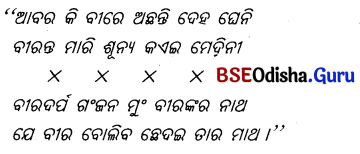
ହୋଇଯାଇଥିଲା । ନିଜର ବେଶଭୂଷାରେ ମଧ୍ୟ ସେ ପିଙ୍ଗଳବର୍ଣ୍ଣ ଜଟା, କଷାୟ ବସ୍ତ୍ର, ତୁଳସୀ ରୁଦ୍ରାକ୍ଷମାଳା ସହ ବାମହସ୍ତରେ ଧନୁ ଓ ଦକ୍ଷିଣ ହସ୍ତରେ କୋଠାର ଧାରଣ କରୁଥିଲେ । ଋଷି ହୋଇ ମଧ୍ୟ ସେ ପିତୃହତ୍ୟାର ପ୍ରତିଶୋଧ ନେବାପାଇଁ ରକ୍ତପାତର ବିଭୀଷିକା ସୃଷ୍ଟି କରିଥିଲେ ।
“ବ୍ରହ୍ମେଣ ବ୍ରହ୍ମ ତୁ ଯୋଗେଣ ଯୋଗେଶ୍ଵର
କ୍ଷତ୍ରୀବୃତ ପଣେ ତୁ ଅଟୁ ଚକ୍ରଧର ।’’
ବ୍ରାହ୍ମଣ କୁଳସମ୍ଭୂତ ପର୍ଶୁରାମ ବ୍ରହ୍ମାଙ୍କ ପରି ଧାନସିଦ୍ଧ, ଶିବଙ୍କ ପରି ମହାଯୋଗୀ ଓ ବିଷ୍ଣୁଙ୍କ ପରି କ୍ଷତ୍ରିୟ କୁଳର ଗରିଷ୍ଠ ଓ ଶ୍ରେଷ୍ଠ ଅଟନ୍ତି । କୌଣସି କ୍ଷତ୍ରିୟର ଗୌରବ ତାଙ୍କ ପାଇଁ ଅସହ୍ୟ । କ୍ଷତ୍ରିୟ କୁଳମଣ୍ଡନ ଶ୍ରୀରାମଙ୍କ ବୀରବାଦ୍ୟ ତାଙ୍କ ପାଇଁ ଅସହ୍ୟ ହୋଇଉଠିଛି । ପିତା ଦଶରଥଙ୍କ ସମସ୍ତ ନିବେଦନ ପ୍ରାର୍ଥନା ଓ କାର୍ପଣ୍ୟତାକୁ ପ୍ରତ୍ୟାଖ୍ୟାନ କରି ସେ ନିଜର ବୈଷ୍ଣବ ଧନୁରେ ଗୁଣ ଚଢ଼ାଇବାପାଇଁ ସେ ଶ୍ରୀରାମଙ୍କୁ ଆମନ୍ତ୍ରଣ କରିଛନ୍ତି । କବିଙ୍କ ବର୍ଣ୍ଣନାରେ “ୟେ କୋଦଣ୍ଡେ ଯେବେ ଦେଇପାରୁ ଗୁଣ/ଜାଣିମା ତୋହର କେତେ ଅଛି ପ୍ରାଣ ।’’
ମହାବୀର ଶ୍ରୀରାମ ବିଜୟପୂର୍ବକ ବୈଷ୍ଣବ ଧନୁରେ ଗୁଣ ଚଢ଼ାଇ ପର୍ଶୁରାମଙ୍କୁ ସ୍ତବ୍ଧ କରିଦେଇଛନ୍ତି । ଜଳନ୍ତା ଅଗ୍ନିରେ ଜଳ ସଞ୍ଚାର ପରି ପର୍ଶୁରାମଙ୍କର ସମସ୍ତ ଦର୍ପ ଦମ୍ଭ ଓ ଅହଙ୍କାରର ଅବସାନ ହୋଇଛି । ଅନୁତାପ ଦଗ୍ଧ
ପାପକୁ ଛେଦନ ପାଇଁ ନିବେଦନ କରିଛନ୍ତି । ପୂର୍ବର ପ୍ରତିଶୋଧ ଅଗ୍ନିରେ ଜର୍ଜରିତ ପର୍ଶୁରାମଙ୍କ ଚରିତ୍ରରେ ଅନୁତାପର ସ୍ନିଗ୍ଧ ଶୀତଳ ଖେବୋକ୍ତିକୁ କବି ଚମତ୍କାର ଭାବରେ ପରିସ୍ଫୁଟନ କରିଛନ୍ତି –
“ବ୍ରାହ୍ମଣ ହୋଇ ପୁଂ କ୍ଷତ୍ରିୟ ବଧକଲି
ଅହନ୍ତାୟେ ଅନେକ ମନିଷ୍ୟ ପାଇଲି ।’’
ବ୍ରାହ୍ମଣ କୁଳସମ୍ଭୂତ ପର୍ଶୁରାମ ଦୟା, କରୁଣା, ସେବା ଓ ସହନଶୀଳତାକୁ ବିସର୍ଜନ ଦେଇ ପ୍ରତିଶୋଧର ଅଗ୍ନିରେ ପୃଥବୀକୁ ଧ୍ୱଂସ କରିଦେଇଛନ୍ତି । ଋଷି ହୋଇ ମଧ୍ୟ ସେ ନିରୀହ ନର ରକ୍ତରେ ଧରଣୀକୁ ରକ୍ତରଞ୍ଜିତ କରିଛନ୍ତି । ସେ ମହାପାପରୁ ମୁକ୍ତିପାଇଁ ସେ ଯୁକ୍ତକରରେ ଶ୍ରୀରାମଙ୍କ ପାଖରେ ଭିକ୍ଷା କରିଛନ୍ତି ।
‘ସ୍ଵର୍ଗକୁ ଗଲେ ମୋତେ ଲାଗିବ ଅବଶ୍ଯ ପାପ
ତୁ ସେ ଶ୍ରୀରାମ ହର ମୋହର ତାପ।’
କରୁଣାନିଧାନ ଶ୍ରୀରାମ ପର୍ଶୁରାମଙ୍କର ପରଲୋକ ପାପର ଛେଦନ କରିବା ସହ ତାଙ୍କର ନର-ରକ୍ତରଞ୍ଜିତ ଧନୁକୁ ଦୁଇଖଣ୍ଡ କରିଦେଇଛନ୍ତି । କ୍ଷତ୍ରିୟ କୁଳର ଧୂମକେତୁ ଦାମ୍ଭିକ ପର୍ଶୁରାମ ପୁନଶ୍ଚ ବ୍ରହ୍ମଣୋଚିତ କାରୁଣ୍ୟ ଓ ଶାନ୍ତ ଓ ଋଷିସୁଲଭ ଗୁଣାବଳୀରେ ମୂର୍ତ୍ତିମାନ ହୋଇଛନ୍ତି । ଧରଣୀପୃଷ୍ଠରୁ ଧ୍ବଂସର ତାଣ୍ଡବଲୀଳାର ଅବସାନ ହୋଇ ଶାନ୍ତି ସହ ପର୍ଶୁରାମ ଚରିତ୍ରରେ ଚମତ୍କାର ଭାବରେ ପରିବର୍ତ୍ତନର ସୂତ୍ରପାତ ହୋଇଅଛି ।
![]()
Question 4.
“ପର୍ଶୁରାମ ଭେଟ’’ କବିତାରେ କବିଙ୍କର ବର୍ଣ୍ଣନାଶୈଳୀ ସମ୍ପର୍କରେ ଆଲୋଚନା କର । ଅଥବା, ଆଲୋଚ୍ୟ ‘‘ପର୍ଶୁରାମ ଭେଟ’’ କବିତାଟିର ଆଧାରରରେ କବି ବଳରାମ ଦାସଙ୍କର ବର୍ଣ୍ଣନା ବୈଚିତ୍ରର ବିଶ୍ଳେଷଣ କର ।
ଉ –
ଭକ୍ତକବି ବଳରାମ ଦାସଙ୍କର ‘ଜଗମୋହନ ରାମାୟଣ’’ର ଆଦ୍ୟକାଣ୍ଡରୁ ଆଲୋଚ୍ୟ ‘ପର୍ଶୁରାମ ଭେଟ’’ ଶୀର୍ଷକ କବିତାଟିର ଉଦ୍ଧାର କରାଯାଇଅଛି । କବି ବଳରାମ ଦାସଙ୍କର ‘ଜଗମୋହନ ରାମାୟଣ’ ଦାଣ୍ଡିବୃତ୍ତରେ ଲିଖ୍ । ଏହି ବୃତ୍ତର ଲକ୍ଷଣ ଅନୁଯାୟୀ ଏହାର ଅକ୍ଷର ସଂଖ୍ୟା ଗୋଟିଏ ଗୋଟିଏ ପାଦରେ ଏଗାରଠାରୁ ବାଇଶ ପର୍ଯ୍ୟନ୍ତ ହୋଇଛି । ଅକ୍ଷର ସଂଖ୍ୟା ସମାନ ନ ରହିଲେ ମଧ୍ୟ ଅନ୍ୟାନ୍ୟ ମିତ୍ରାକ୍ଷରର କବିତା ପରି ଏହାର ଦୁଇପାଦରେ ଏକ ପଦ ହୁଏ । ପାଦଦ୍ୱୟର ଶେଷ ଅକ୍ଷରରେ ମେଳ ରହିଥାଏ । ଗାୟକ ନିଜର ସୁବିଧା ଅନୁସାରେ ନିଜର ସ୍ୱରକୁ ଲମ୍ବାଇ କିମ୍ବା କମାଇ କରି ଯତିପାତ କରିଥାଏ । କବି ବଳରାମ ଦାସଙ୍କର ଆଲୋଚ୍ୟ ‘ପର୍ଶୁରାମ ଭେଟ’ କବିତାଟି ‘ଜଗମୋହନ ହୋଇଥାଏ ।
ଏତଦ୍ବ୍ୟତୀତ କବିଙ୍କର ଶବ୍ଦ ସଂଯୋଜନା, ବର୍ଣ୍ଣନା ବୈଚିତ୍ର ତଥା ସେହି ସମୟର ସାମାଜିକ ଚିତ୍ର ଓ ଲୋକ ବିଶ୍ୱାସକୁ କବି ଅତି ଚମତ୍କାର ଭାବରେ ଉକ୍ତ କବିତାଟିରେ ପରିସ୍ଫୁଟନ କରାଇ ପାରିଛନ୍ତି ।
ସେହି ସମୟର ସାମାଜିକ ପ୍ରଥା ଅନୁସାରେ ବୀରଶ୍ରେଷ୍ଠ କ୍ଷତ୍ରିୟ ରାଜାମାନଙ୍କୁ ଆନୁଗତ୍ୟରେ ଅନ୍ୟ ରାଜ୍ୟର ରାଜାମାନେ ବିଭିନ୍ନ ଉପହାରମାନ ପ୍ରଦାନ କରିଥା’ନ୍ତି । ମର୍ଯ୍ୟାଦାପୁରୁଷ ଶ୍ରୀରାମଚନ୍ଦ୍ର ଦୁର୍ଜୟ ଶିବଧନୁକୁ ଭଗ୍ନକରି ସୀତାଙ୍କୁ ବିବାହ କରିବାଦ୍ଵାରା ତାଙ୍କର ଯଶଖ୍ୟାତି ଓ ବୀରତ୍ବ ସମଗ୍ର ପୃଥିବୀର ରାଜାମାନଙ୍କୁ ତାଙ୍କ ପ୍ରତି ଅନୁରକ୍ତ ତଥା ଅନୁଗତ କରିଦେଇଥିଲା । ତେଣୁ ଫେରନ୍ତା ବାଟରେ ରାଜାମାନେ ତାଙ୍କୁ ବିଭିନ୍ନ ଉପହାରମାନ ପ୍ରଦାନ କରି ଉଚ୍ଛସିତ ସମ୍ବର୍ଦ୍ଧନା ଜଣାଇଥିଲେ । କବି ଏହି ଲୋକପ୍ରଚଳିତ ପାରମ୍ପରିକ ରୀତିକୁ ଅତି ସୁନ୍ଦର ଭାବରେ ବର୍ଣ୍ଣନା କରିଛନ୍ତି ।
“ମିଥିଳା କଟକରୁ ସେ ହୋଇଲେ ବାହାର
ବାଟେ ରାଜାମାନେ ଯେ ଦିଅନ୍ତି ଉପହାର ।’’
କବିତାଟିର ପରବର୍ତ୍ତୀ ପର୍ଯ୍ୟାୟରେ ଦଶରଥ ବିଭିନ୍ନ ଅଶୁଭ ଶଙ୍କୁନମାନ ଦେଖୁ ବିଚଳିତ ହେବା ଯଥା ବାମ ନୟନର ସ୍ଫୁରଣ, ଶାଗୁଣା, ବିଲୁଆ ଓ କାକ ପ୍ରଭୃତି ପଶୁପକ୍ଷୀଙ୍କ ଆଗମନ, ଧୂମକେତୁର ଆବିର୍ଭାବ, ସୂର୍ଯ୍ୟଙ୍କ କିରଣ
ମୁହଁରେ ସ୍ଵୀକାର କରିଛନ୍ତି –
“ୟେର ଶଙ୍କୁନ ମାନ ଯେ ବିପରୀତ ଦିଶଇ
ମୋହର ମନକୁ ୟେ ଶୁଭ ନ ଆସଇ ।’’
କବିତାଟିର ପରବର୍ତ୍ତୀ ପର୍ଯ୍ୟାୟରେ କବି ବଳରାମ ଦାସ ପଞ୍ଚମ-ଷୋଡ଼ଶ ଶତାବ୍ଦୀରେ ମଧ୍ଯ ସୁନ୍ଦର ଉପମା ପ୍ରୟୋଗ କରି ଆଲୋଚ୍ୟ କବିତାଟିକୁ ଅତ୍ୟନ୍ତ ରୋଚକ ତଥା ଶ୍ରୁତିମଧୁର କରିଛନ୍ତି । ଦଶରଥଙ୍କ ବିଶାଳ ସୈନ୍ୟବାହିନୀକୁ
ସମୁଦ୍ର ଜଳକୁ ଉଦରସ୍ତ କରିଦେଲାପରି ପର୍ଶୁରାମଙ୍କ ପ୍ରଭାବ ନିକଟରେ ରାଜାଙ୍କ ସୈନ୍ୟମାନେ ଅତି ନଗଣ୍ୟ ଥିଲେ । କବି ଏହି ବ୍ୟତିକ୍ରମକୁ ଚମତ୍କାର ଉପମା ପ୍ରୟୋଗ କରି ବର୍ଣ୍ଣନା କରିଛନ୍ତି –
‘ସମୋଦ୍ରକୂଳେ କି ଅଗସ୍ତି ଆସି ହୋୟେ
ଦେଖୁଣ ସନ୍ୟହିଂ ଯେ କଲେ ମହାଭୟେ ।’’
ସେହିପରି କବି ମହାଯୋଦ୍ଧା ପର୍ଶୁରାମଙ୍କୁ କବି ପ୍ରଳୟ ଅଗ୍ନି ଓ ସୂର୍ଯ୍ୟଙ୍କ ସହ ତୁଳନା କରି ରାଜାଙ୍କର ସୈନ୍ୟମାନଙ୍କୁ ପୃଥିବୀ ସହ ତୁଳନା କରିବା ମଧ୍ୟ କବିଙ୍କର ସୁନ୍ଦର ଉପମା ପ୍ରୟୋଗର ଦୃଷ୍ଟାନ୍ତ ଅଟେ ।
ରୋଚକ ଓ ରସପୂର୍ଣ୍ଣ କରିଦେଇ ଅଛି । ବୀରଶ୍ରେଷ୍ଠ ଶ୍ରୀରାମଚନ୍ଦ୍ର ଶିବଧନୁ ଭଗ୍ନକରି ସୀତାଙ୍କୁ ବିବାହ କରିଥିଲେ । ପଥ ଆଶଙ୍କା କବିବର ବିଚିତ୍ର ରସାନୁଭୂତିର ପରିଚୟ ଦିଏ । କବି ଅତି ସୁନ୍ଦର ଭାବରେ ଦେବୀ ସୀତାଙ୍କର ମାନସିକ ଅନ୍ତର୍ଦାହକୁ ପରିସ୍ଫୁଟନ୍ କରାଇ ବର୍ଣ୍ଣନା କରିଛନ୍ତି –
“କୋଦଣ୍ଡ ଆମଞ୍ଚନ୍ତେ ମୋତେ ବିଭାକଲା ।
ୟେବେ ତ ଯେ ଋଷି ଦିଅଇ ଶରାସନ
ଚାପ ଆମଞ୍ଜୁଲେ ଦେବ କନ୍ୟାଦାନ ।”
ମନସ୍ତତ୍ତ୍ଵକୁ ଅନୁସରଣ କରି ‘ତପସ୍ବିନୀ’ରେ ମଧ୍ୟ ପରିସ୍ଫୁଟନ କରିଛନ୍ତି –
‘‘ଦୂତମୁଖୁ ଶୁଣି ଏବେ ଅଶ୍ଵମେଧ କଥା
ଜାନକୀ ହୃଦୟେ ହେଲା ଆକସ୍ମିକ ବ୍ୟଥା ।
ଅଙ୍କେ ବସାଇଲେ ଆଣି ଦ୍ଵିତୀୟା ରମଣୀ ।’’
ଏହିଠାରେ ତ ଗୋଟିଏ କବିର ବର୍ଣ୍ଣନା ବୈଶିଷ୍ଟ୍ୟ ଚରମସୀମାକୁ ସ୍ପର୍ଶ କରିଥାଏ – ଯେଉଁଠି ତାହା ଉତ୍ତର ପିଢ଼ିକୁ ଯେପରି ରୁଚିପୂର୍ଣ୍ଣ ସେହିପରି ଚମତ୍କାର ସୁଦୂରପ୍ରସାରୀ ଅଟେ ଯାହା ଆଗାମୀ ସ୍ରଷ୍ଟା ମାନସରେ ଆଲୋଡ଼ନ ସୃଷ୍ଟି ହୋଇଥାଏ ।
![]()
Question 5.
ପଠିତ କବିତା ଅବଲମ୍ବନରେ ପର୍ଶୁରାମଙ୍କର ଅହଙ୍କାରର ପତନ କିଭଳି ହୋଇଥିଲା ବର୍ଣ୍ଣନା କର । ଅଥବା, ଆଲୋଚ୍ୟ କବିତାକୁ ଅନୁସରଣ କରି ପର୍ଶୁରାମଙ୍କ ଅହମିକାରୂପୀ ସୂର୍ଯ୍ୟ କିପରି ଅସ୍ତମିତ ହୋଇଥିଲା ଆଲୋଚନା କର ।
ଉ –
ଆଲୋଚ୍ୟ ‘ପର୍ଶୁରାମ ଭେଟ’’ ଶୀର୍ଷକ କବିତାଟି ଭକ୍ତକବି ବଳରାମ ଦାସଙ୍କ ବିରଚିତ ‘ଜଗମୋହନ ରାମାୟଣ’’ର ଆଦ୍ୟକାଣ୍ଡର ଅଂଶବିଶେଷ ଅଟେ । ଏଠାରେ କବି କ୍ଷତ୍ରିୟ କୁଳ-ନିସୂଦନ ମହାବୀର -ମହାତେଜା ପର୍ଶୁରାମଙ୍କର ଔଦ୍ଧତ୍ୟ ଓ ଅହମିକା ଉପରେ ଆଲୋକପାତ କରିଛନ୍ତି । ମହାତେଜା ପର୍ଶୁରାମ ମହର୍ଷି ଯମଦଗ୍ନି ଓ ରେଣୁକାଙ୍କର ପୁତ୍ର ଥିଲେ । ପର୍ଶୁରାମଙ୍କର ଅନୁପସ୍ଥିତିରେ କ୍ଷତ୍ରିୟ ରାଜ ସହସ୍ରାର୍ଜୁନ (କାର୍ତବୀର୍ଯ୍ୟ) ତାଙ୍କ ପିତା ଯମଦଗ୍ନିଙ୍କୁ ଅନ୍ୟାୟ ଯୁଦ୍ଧରେ ନିଧନ କରିଥିବାରୁ ପର୍ଶୁରାମ ସେହିଦିନଠାରୁ ନିଜ ପିତୃହତ୍ୟାର ପ୍ରତିଶୋଧ ନେବାପାଇଁ ଅତ୍ୟନ୍ତ ଉଗ୍ର ଓ ଉଦ୍ଦଣ୍ଡ ହୋଇପଡ଼ିଥିଲେ । ଏକବିଂଶବାର ଯୁଦ୍ଧଯାତ୍ରା କରି ସେ ସମୟର ପୃଥିବୀକୁ କ୍ଷତ୍ରିୟ ଓ ବୀରଶୂନ୍ୟ କରିଦେଇଥିଲେ । ଧ୍ୟାନରତ ଥିଲେ ।
ଅନ୍ୟ ପକ୍ଷରେ ଅଯୋଧ୍ୟାରାଜ ଦଶରଥଙ୍କ ପୁତ୍ର ଶ୍ରୀରାମଚନ୍ଦ୍ର ମିଥୁଳାରେ ଶିବଧନୁ ଭଗ୍ନକରି ଜନକନନ୍ଦିନୀ ପୁତ୍ରବଧୂଙ୍କ ସହ ଅଯୋଧ୍ୟା ପ୍ରତ୍ୟାଗମନ ଅବସରରେ ସିଦ୍ଧବନରେ ବିଶ୍ରାମ ନେଇଛନ୍ତି । ବୀରତ୍ବର ବାଦ୍ୟରେ ପର୍ଶୁରାମଙ୍କର ଧ୍ୟାନଭଗ୍ନ ହୋଇଛି । ସମସ୍ତ ପୃଥିବୀକୁ ସେ ବୀରଶୂନ୍ୟ କରି ଦେଇଛନ୍ତି । ପୁନର୍ବାର ବୀରତୁର ବାଦ୍ୟରେ ସେ ସ୍ତଚକିତ ହୋଇ ବିଚାର କରିଛନ୍ତି –
“ଆବର କ ବୀରେ ଅଛନ୍ତି ଦେହ ଘେନି
ବୀରନ୍ତ ମାରି ଶୂନ୍ଯ କଲଇ ମେଦିନୀ ।
ନିଜ ପିତୃହତ୍ୟାର ପ୍ରତିଶୋଧ ନେବାପାଇଁ ସେ କ୍ରୋଧରେ ଅନ୍ଧ ହୋଇଯାଇଛନ୍ତି । ବ୍ରାହ୍ମଣ ହୋଇ ମଧ୍ୟ ସେ କ୍ଷତ୍ରୀୟ-ରାଷ୍ଟ୍ରରେ ନିଜର କରବାକ-ରଞ୍ଜିତ କରିଛନ୍ତି । ଉଗ୍ର ଓ ଉଦଣ୍ଡ ମୂର୍ତ୍ତି ଧାରଣକରି ସେ ସମଗ୍ର ପୃଥିବୀକୁ ବୀରଶୂନ୍ୟ କରିବା ସହିତ ନରରକ୍ତରେ – ଧରଣୀକୁ ଜର୍ଜରିତ କରିଦେଇଛନ୍ତି । ପର୍ଶୁରାମଙ୍କର ଅହମିକାର ପରିଚୟ ତାଙ୍କରି ନିଜସ୍ଵ ମତରେ ସେ ପରିପ୍ରକାଶ କରିଛନ୍ତି ।
“ବୀରଦର୍ପ ଗଂଜନ ମୁଂ ବୀରଙ୍କର ନାଥ
ଯେ ବୀର ବୋଲିବ ଛେଦଇ ତାର ମାଆ’’।
କ୍ଷତ୍ରିୟ କୁଳର ବୀରତ୍ଵ ତାଙ୍କ ପାଇଁ ଅସହ୍ୟ । ତେଣୁ ବୀରଶ୍ରେଷ୍ଠ ଶ୍ରୀରାମଙ୍କର ବୀରବାଦ୍ୟ ଶୁଣି ସେ ଅସନ୍ତୁଷ୍ଟ ହୋଇପଡ଼ିଛନ୍ତି । ପିତୃହତ୍ୟାର ପ୍ରତିଶୋଧ ବହ୍ନି ପୁନର୍ବାର ତାଙ୍କର ପ୍ରଜ୍ଵଳିତ ହୋଇଉଠିଛି । ତେଣୁ ସେ ଧ୍ୟାନରତ-ମୃଗଚର୍ମ-ପରିହିତ ତୁଳସୀମାଳାଧାରୀ ବେଶରେ ଧନୁ ଓ କୋଠାର ଧାରଣ କରି ଉଗ୍ର ଓ ଉଦ୍ଦଣ୍ଡ ଦଶରଥଙ୍କ ସମ୍ମୁଖରେ ଆବିର୍ଭାବ ହୋଇଛନ୍ତି ।
ଦଶରଥଙ୍କ ସମସ୍ତ ଆଇଁ ପ୍ରାର୍ଥନା ଓ ଅନୁନୟ ବିନୟକୁ କର୍ଣପାତ ନକରି ସେ ପୁତ୍ର ଶ୍ରୀରାମଙ୍କ ବୀରତ୍ବର ପରୀକ୍ଷା ନେବାପାଇଁ ଅତ୍ୟନ୍ତ ବ୍ୟଗ୍ର ଓ ଉଗ୍ର ହୋଇପଡ଼ିଛନ୍ତି । ମେରୁଠାରୁ ଗରୀୟାନ ଓ ବଜ୍ରଠାରୁ ଶକ୍ତ ଶିବଧନୁକୁ ଖଣ୍ଡବିଖଣ୍ଡ କରିଦେଇଥିବା ଶ୍ରୀରାମଙ୍କୁ ସେ ନିଜର ବୈଷ୍ଣବଧନୁରେ ଗୁଣଚାଳନା କରି ବୀରତ୍ଵର ପ୍ରମାଣ ଦେବାପାଇଁ ବାଧ୍ୟ କରିଛନ୍ତି ।
ମହାବୀର ଶ୍ରୀରାମ ବିନୟ ସହକାରେ ପର୍ଶୁରାମଙ୍କ ଚରଣ ବନ୍ଦନା କରି ଉକ୍ତ ଆହ୍ୱାନକୁ ସ୍ବୀକାର କରିଛନ୍ତି । ପରମୂହୁର୍ତ୍ତରେ ସେ ସେହି ଦିବ୍ୟଧନୁରେ ଗୁଣ ଚାଳନା କରି ପର୍ଶୁରାମଙ୍କୁ ସ୍ତବ୍ଧ ଚକିତ କରିଦେଇଛନ୍ତି । କବିଙ୍କ ବର୍ଣ୍ଣନାରେ –
“ବାମ ଭୁଜେ ଧରି ନଦିଲେ ବାମପାଦ
ଗୁଣ ଦିଅନ୍ତେ ପ୍ରଶୁରାମ ହୋଇଲେ ତବଦ ।”
ମହାତେଜା ପର୍ଶୁରାମଙ୍କର ସେହି ମହାଶକ୍ତିଶାଳୀ ଧନୁକୁ ସେ ବାମହାତର ଖେଳପରି ସେଥୁରେ ଗୁଣ ଚଢ଼ାଇଛନ୍ତି । ଅପକର୍ମକୁ ସେ ରୋମନ୍ଥନ କରିଛନ୍ତି । ପ୍ରତିଶୋଧପରାୟଣ ହୋଇ ସେ ନର-ରକ୍ତରେ ଧରାରଞ୍ଜିତ କରି ଧରଣୀକୁ ହାହାକାରମୟ କରିଦେଇଛନ୍ତି । ତେଣୁ ସେ ଶ୍ରୀରାମଙ୍କୁ ନିଜର ଅପକର୍ମ ଓ ପାପଭାରରୁ ମୁକ୍ତି ପାଇଁ ପରଲୋକକୁ ଧନୁଚାଳନା ପାଇଁ ପ୍ରାର୍ଥନା କରିଛନ୍ତି । ମର୍ଯ୍ୟାଦାପୁରୁଷ ଶୀଳ ଓ ବିନମ୍ର ଶ୍ରୀରାମଙ୍କ ବ୍ୟକ୍ତିତ୍ଵ ଓ ବୀରତ୍ଵ ନିକଟରେ ଉଗ୍ର ଉଦ୍ଦଣ୍ଡ ପର୍ଶୁରାମଙ୍କ ସମସ୍ତ ଔଦ୍ଧତ୍ୟ ଓ ଅହମିକାର ଅବସାନ ହୋଇଛି । ତାଙ୍କର ଅହଂକାରରୂପୀ ସୂର୍ଯ୍ୟ ଅସ୍ତାଚଳଗାମୀହେବା ସହ ସେ ହୋଇ ସ୍ୱସ୍ଥାନ ପ୍ରତ୍ୟାବର୍ତ୍ତନ କରିଛନ୍ତି ।
କଠିନ ଶବ୍ଦାର୍ଥ ଓ ସୂଚନା:
